








OUR GUIDING PRINCIPLES:
1. Believe in all things others say can’t be doneTM
We excel when solving our clients’ problems — and our own — by creating solutions that did not exist yesterday. We understand that success requires the ability to recognize and discard outdated solutions, to transform our environment to generate truly innovative ideas and exciting new directions.
2. What won’t happen under my watchTM
Our primary responsibilities are to preserve our clients’ financial values and to help them achieve their financial goals. We exercise extreme diligence to ensure that they enjoy the benefits of the most knowledgeable resources in all areas of financial management. As we safeguard our clients’ future, we also safeguard our own as a successful, leading-edge company.
3. Know your resources and treasure themTM
We identify and expand on our existing strengths to create extraordinary opportunities to achieve our goals. Whether those strengths are innovative ideas, financial expertise, or cutting-edge technology, if used to their highest potential, and implemented by the right team of specialists, they will produce outcomes never thought possible.
4. Enjoy the rideTM
Life is full of exciting opportunities that challenge us to learn, and to grow. We have created a company that asks both our clients and our employees to embrace the challenges, the learning, and the growth; through these exciting experiences, they will find unimaginable success.

























Learning pays dividends — and it’s the first step to leaving a legacy
For many people, the first step in achieving financial stability is recognizing the challenge of going it alone.
There are so many money-related concerns, from tackling debt to investing smartly, and sorting it all out without a professional financial team like the one at Hantz Group is, to use a popular movie title, isky Business

BY R.J. KING / ILLUSTRATION BY
ANDY POTTS


But once a team and a plan are in place and activated, the feeling of wishful thinking that everything will somehow work out in the end gives way to real, grounded confidence.

“One of our strengths is the broad array of services we provide, so wherever our clients are in their financial journey, we have the expertise to help them reach their goals,” says John Hantz, founder, president, and CEO of Hantz Group. “ hether it’s tax planning, estate planning, insurance strategies, or asset management, we believe that our holistic approach to financial planning creates greater freedoms and e ciencies for our clients.”
Embarking on an intentional, learning-focused financial journey can lead to rather remarkable returns, particularly once all debt is paid off. Freed from the weight of money owed, individuals may find that personal goals that once seemed insurmountable are now within reach.
























R.J. King, editor of DBusiness magazine.



For example, a second home may be no longer a mirage. Step by step, over a period of time, as money is set aside to buy a home in a resort community or a lakefront residence in a rural oasis, dreams become reality.
Standing at the precipice of benevolence brings with it a new set of challenges. Indeed, creating an endowment, establishing a foundation, or leaving a gift that will make the world a better place requires a new level of financial expertise.


of jobs and rekindled the regional economy.
In a manufacturing city like Detroit, the investment spurred by Hantz Woodlands has brought its own sense of déjà vu — people can walk to work again just as they did before the automobile arrived.
So what happens when all the personal goals are met? The kids have graduated from college and are pursuing promising careers; the houses, cars, boat, and motor home are paid off college savings plans are in place for future grandchildren; and the American Dream has been realized.
The next step is to make a difference by leaving a legacy.



Hantz and his team know a thing or two about leaving a lasting impact. More than a decade ago, they began investing in what would become Hantz Woodlands on Detroit’s east side, near Indian Village. There, they have acquired and maintained vacant lots and alleys, planted thousands of hardwood saplings, renovated and built homes, encouraged commercial development, and invested in the surrounding community via the Hantz Foundation. Along the way, blight and abandonment have given way to stability and prosperity.
Today, the Hantz Woodlands initiative, which is ongoing, has led to cleaner, safer neighborhoods and has raised property values. What’s more, local businesses have sprouted up or expanded, which has led to the creation



At the same time, the activity at Hantz Woodlands has arguably strengthened Detroit’s “Motor City” moniker. After all, in May 2022, following three years of construction, Stellantis completed a $1.6 billion expansion of its Jefferson orth Assembly Plant, located several blocks east of Hantz Woodlands. The investment was made, in part, because of the sustainable turnaround in the surrounding neighborhoods.
What does all this mean for individuals on their financial journey Hantz Group clients know that their financial services company has what it takes to build a legacy that will last for generations. On a smaller scale, clients can work with their designated team to do the same.



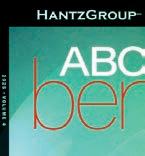

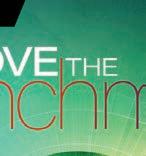

















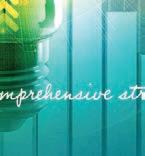





























Many parts, one comprehensive strategy
elcome to the fourth edition of Above the Benchmark, Hantz Group’s annual magazine. Our focus for this issue is learning and education, and our goal is for our clients to use Above the Benchmark as a manual for continuing their financial education. e want our clients to stay informed as they progress through their financial journeys.
Education is the backbone of our holistic approach. After all, to achieve the best outcomes, clients and advisors must be on the same page about the clients’ financial goals and effective strategies to achieve them. To understand how to reach your financial goals, you have to understand the “why” and “how” behind those strategies. This is where education comes in a key part of the Hantz Group advisors’ and specialists’ roles is to ensure you understand the “why” and “how.”
Doug Lennick, longtime mentor of CEO John Hantz, puts it simply “Financial intelligence is the ability to make smart, responsible, values-driven decisions with our resources and our
lives. It’s aligning behaviors with what really matters.”
This issue will also give you a deeper look into some of our people across the company those who live our guiding principles to the fullest.
Specialists across our main disciplines will also dive into important and timely issues related to their areas of expertise
Compliance: Learn more about common financial scams and what to look out for.
Home and Auto Insurance: The property and casualty environment is rapidly changing, but Hantz Agency has strategies to help. Learn more about what is causing the rapid changes.
Life Insurance: Learn more about how different life insurance strategies can be used throughout the stages of your life, which we call the comfort levels.
Estate Planning: The team at Hantz Trust takes a deeper dive into how the holistic approach works within the estate planning process.






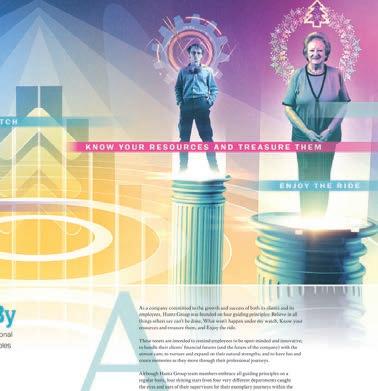
















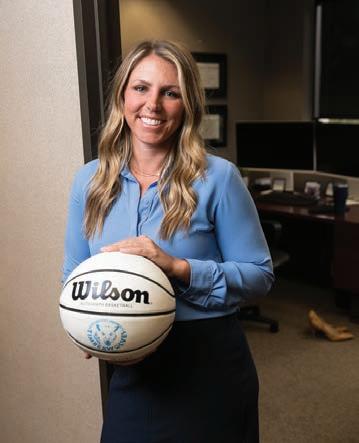








Andy Potts and The Heads of State are the creatives behind this year’s artwork
With Above the Benchmark, we hope to bring you not only useful information about our holistic approach to financial planning but also visually interesting layouts punctuated by original artwork.
This year, we’re working with two new illustrators who have lent their unique talents and styles to our pages and brought the content here to life.

Tax Planning: Hear from the president of Hantz Tax & Business on tax planning across our comfort levels as well as some upcoming legislative changes.
Debt Strategies: Our chief lending o cer explains why an extra $100 a month when partnered with the right refinancing strategy can make a world of difference.
Investments: The asset management team at Hantz Group takes you through updates related to the launch of its active exchange traded fund (ETF) offering, American Drive Model Portfolios (ADMP).
Banking: Learn more about Hantz Credit Union and the benefits built for its members.
Financial Planning: Mastering your finances requires you to be aware of what you know and how you feel. Learn more about emotional competency and the role that plays in the holistic approach.
e hope you enjoy this year’s magazine, and we look forward to continuing to grow and learn together.
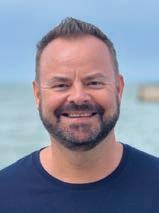

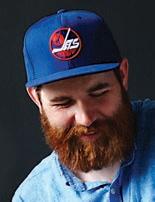
Andy Potts is an illustrator/animator based in Margate in the U.K. He has a dynamic digital-collage style combining 2D and 3D elements. During his prolific and award-winning career, he has been commissioned by many global clients across editorial, advertising, publishing, and design. You’ll find his illustrations on the cover and in the stories about Hantz Woodlands (page 8) and Hantz Group’s guiding principles (page 16).
For more than 15 years, Jason Kernevich and Dustin Summers have been working together as The Heads of State. Throughout their careers, they’ve created an award-winning mix of designs and illustrations for a diverse and impressive list of clients. Their bold style has elevated iconic brands, well-loved bands, books, packaging, hot-button issues, small businesses, cultural institutions, and urban experiences. They lecture frequently about their work and process and teach graphic design and illustration at Tyler School of Art, where they both studied. You’ll find their illustrations paired with articles throughout this magazine.
“AN
At Hantz Group, we pride ourselves on having a strong team made up of individuals from a variety of disciplines. Together, they develop and execute plans to help our clients make the most of their finances. The most important member of the team isn’t any of these specialists, though — it’s the client.
ithout a client’s full participation, the rest of the Hantz team can’t do its job. And for clients to be active members of the team, they have to understand how the various components of their financial picture work and fit together, what their goals are, and what they need to do to achieve

Pat Nelson, Financial Advisor, CFP®, MBA (Bay City)
If my team and I deliver the holistic approach guided by the “why” from the client, then the solutions and strategies come naturally. e then simply need to explain the recommendations to the client in a way that they understand, and they will normally come to the same conclusions that we did in our case study.
those goals. There’s a Hantzism that sums up this concept: “An educated client is a good client.”
Educating clients through the annual deepdive meeting, this magazine, and other avenues is one of our most important jobs, and the payoff can be incredible as clients realize their goals. (Of course, Hantz team members such as Nicholas Elliott, quoted here — are always learning from each other as well!) Here, some members of the team weigh in on why “an educated client is a good client.” Contributors were nominated by leadership across Hantz Group as those who have a particularly deep understanding of this Hantzism.
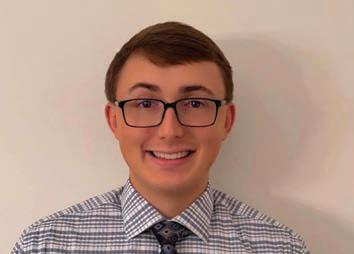
Nicholas Elliott, Financial Advisor (Bay City)
It starts with managing and setting the correct expectations. It’s simple, just not easy, which is the most important concept I’ve learned from working with Pat Nelson so far. I take that approach when talking with clients, taking the time to understand the situation (both good and not so fun), and placing myself in their shoes to make sure that my answer would satisfy my own expectations before explaining and helping on the next steps that are needed with the client.
EDUCATING CLIENTS — THROUGH THE ANNUAL DEEP-DIVE MEETING, THIS MAGAZINE, AND OTHER AVENUES — IS ONE OF OUR MOST IMPORTANT JOBS, AND THE PAYOFF CAN BE INCREDIBLE AS CLIENTS REALIZE THEIR GOALS.
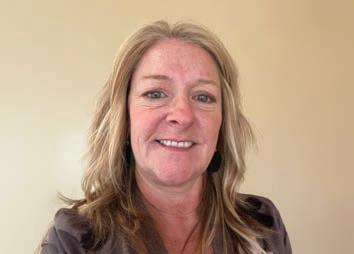
Julia Gervasio, Advanced Tax Planning Specialist and District Manager, CPA (Sault Ste. Marie)
This phrase expresses why the client is the most important part of our team. hen a client understands the role they play in providing accurate and timely information, the better we, as advisors, can provide solutions and strategies to help them achieve their goals.











Jon Chapman, Advanced Planning Specialist, ChFC®, MBA (Saginaw)
Insurance in general is the least understood financial product in our industry. This presents challenges to us on a daily basis as we work with our clients to find solutions that fit their specific needs instead of using rules of thumb and worn-out analogies. Our job is to help our clients understand all the different strategies that are applicable to their situation as they move through the three comfort levels. The challenge for us is not only to educate the clients on all the different types of insurance but more importantly to show them how we would use the products correctly in their situation. There is no more satisfying feeling than seeing the clients come full circle and understand the concepts and how they make them better off in the long run.















Sierra Clow, Investment Analyst and Financial Advisor (Okemos)
As a financial advisor, one of the most important things I can do for my clients is to be their teacher and educator. As my clients become more educated, they grow in their economic literacy and emotional fortitude, which helps make sure we are on the same page.







Roger Letourneau, Lending Specialist (Ann Arbor)

ith the current interest rate environment, there is usually a short window where refinancing makes sense, which means we need to move fast on it. An educated client understands this and knows we are watching the market to give them the best time to refinance and help them become debt-free. Educating the clients helps them understand the “why” and how all the parts fit together in their financial plan.


What would happen if someone invested in 1 square mile of blighted land in Detroit and cleaned it up?
What if they demolished abandoned houses, cleared decades of brush, mowed the grass, and planted trees? And what if they kept doing that, for more than a decade, with no intention of stopping? Welcome to Hantz Woodlands.
BY WENSDY VON BUSKIRK / ILLUSTRATION BY ANDY POTTS
When I drive to Detroit to interview Mike Score, president of Hantz Woodlands,
I picture riding an elevator up to a smoothtalking executive in a fancy o ce building surrounded by trees. Instead, I pull up to find a slight man in Carhartts and suspenders waiting on the stoop of an old brick warehouse in the middle of a neighborhood.
As I park, Score walks over, balancing his steps with a gold-handled cane. He leads me through a first-floor garage packed with groundskeeping equipment, up a steep stairway, and to a conference room with creaky floors, exposed brick walls, and sparse furnishings. This is Hantz oodlands H .
Score gestures for me to sit at a conference table where a black journal lies open to reveal his handwritten notes about the Hantz oodlands







1

project, which he has overseen since its inception in 200 . The pages are full.
210




“This is o. 3 ,” he tells me about the notebook. “ hen I learn something, I write it down.”
Hantz oodlands began when John Hantz decided to see if he could do something to help reverse blight in Detroit. Instead of an overwhelming plan for the whole city, why not start small?
“A big, big problem needs a big, big solution, but what if we did something simple, affordable, and replicable That could work,” Score explains.
In 200 , Hantz set his sights on buying 1 square mile adjacent to his then-neighborhood of Indian Village and hired Score to help write the business plan for an urban farm. The process, detailed brilliantly in the documentary Land Grab, would turn out to be more di cult and

2,200 PROPERTIES PURCHASED

convoluted than Hantz could have imagined, fraught with politics, protests, and delays. It took more than four years before Detroit City Council approved the deal, and another year before the first trees were planted.
Score has since stepped away from the backbreaking work it took to clear decades of brush, demolish 6 abandoned homes, and plant 36,000 trees, which far exceeded the initial plans for Hantz oodlands. ow in semiretirement, Score, who has handed off maintenance duties to four hardworking employees, has time to reflect on the enormity of the undertaking and sift through his notebooks one at a time.
“Hopefully, I can distill something meaningful, lessons learned that I think are true and that can be a benefit to someone else,” he says.
After we talk in the conference room, Score takes me on a tour of the property.





76 BLIGHTED BUILDINGS RAZED










36,000 TREES PLANTED $10 MILLION INVESTED


600+
NEW ROOFS ON RESIDENTIAL PROPERTIES

5 EMPLOYEES


“‘PROMISES MADE, PROMISES KEPT’ IS THE MOST VALUABLE CURRENCY THAT WE HAVE. WE WILL STAY HERE AND KEEP MANAGING THE LAND. OUR ULTIMATE GOAL IS TRULY LIVABLE NEIGHBORHOODS.”
—MIKE SCORE, PRESIDENT OF HANTZ WOODLANDS
We pass neat rows of sugar maples, white oaks, black cherry trees, and tulip poplars, now taller than men, their leaves fanning out against the blue sky. But as we drive, I see much more than trees taking root in the neighborhood. Score points out a centuryold church transformed by the Library Street Collective into The Shepherd, a cultural arts center with rotating exhibits, an outdoor sculpture park, and a boutique bed-andbreakfast. He nods toward a building being renovated for an Italian restaurant, bar, and coffee shop and mentions The Shepherd’s skate park, backed by Tony Hawk himself.
He tells me that a developer has optioned 10 acres and built six houses so far with two additional homes under construction and plans for 200 more. Another deal is currently in negotiation for a senior living campus.
All this investment has led to a steep rise in property values, allowing longtime residents to realize gains and reinvest. With new equity to make improvements, more than 500 residents have replaced their roofs, another symbol of the neighborhood’s revitalization.
“When we started, a vacant lot was worthless.
ow they’re going for $40,000 to $50,000,” Score says.
None of this would have happened without the $10 million kick start provided by Hantz Woodlands, Score says. As other investors eye the downtown, Midtown, and Corktown neighborhoods, Hantz Woodlands provides an example of how private investment can help Detroit neighborhoods thrive.
It’s one thing to buy land. It’s another to tend it, day after day, week after week, year after year. That’s what it takes, that’s what Hantz oodlands has committed to, and that’s the main lesson Score has learned over 16 years and countless pages of meticulous notes.
“ Promises made, promises kept’ is the most valuable currency that we have,” Score says. “We will stay here and keep managing the land. Our ultimate goal is truly livable neighborhoods.”

The Hantz Foundation tackles student and teacher retention at three Detroit schools
BY WENSDY VON BUSKIRK
At the end of the 2023–2024 school year, 400 children from two Detroit schools boarded buses for a field trip to Emagine, the movie theater. When they arrived, they were treated like stars, getting their photos taken in front of a step-and-repeat banner and reclining in their seats with soda and popcorn for a screening of the blockbuster IF
“We host students who are being rewarded for their yearlong achievements in academics and attendance,” explains Lauren Hantz, president of the Hantz Foundation.
Movie Day is just one example of how the Hantz Foundation supports schools in the Hantz Woodlands neighborhood. Postpandemic, the organization has focused on efforts to retain students and teachers through programming and events that incentivize kids to come to class and that show educators they are valued.
Laying a Foundation
The Hantz Foundation was formed to complement the work of Hantz Woodlands, which combats blight in 1 square mile of Detroit by tearing down abandoned buildings and tending the land (see related story on page 8).
“THESE EVENTS HELP [STUDENTS] ENGAGE AND SEE THE IMPORTANCE OF THEIR HARD WORK.”
—LAUREN HANTZ, PRESIDENT OF THE HANTZ FOUNDATION
“We got to the end where we had planted everything we could, and we were like, ‘What do we do next?’” Hantz recalls. “We really want to support this community as a whole, and the next step was helping the residents and addressing the needs there.”
Founded in 2013, the nonprofit is on a mission to create partnerships in the community that lead to future success. After asking residents where they most wanted assistance, the Hantz Foundation concentrated on the schools.
“A resounding answer in conversation with





















and teacher
the neighborhood centered on their concern over the next generation and making sure that the children growing up in this area were taken care of,” Hantz says. “Many of their grandparents or parents had grown up in this square mile. They had lived there their whole life, and they wanted to see this progress and prosperity really impact those families, and we agreed.”
The Foundation has supported three schools within the Woodlands footprint for about a decade: Detroit Enterprise Academy, Hutchinson ElementaryMiddle School at Howe, and Southeastern High School.
Different schools have different needs at different times, Hantz explains, but for all three of these Detroit schools, retention of students and teachers post-pandemic has been paramount. Many schools across the U.S. did not return to “normal” when students returned to the classroom; the
pandemic had a lasting impact on attitudes toward the importance of consistent attendance, and some people became lax, according to a 2023 report from the Center on Reinventing Public Education and a 2024 article from the American Enterprise Institute.
Student attendance is a strong predictor of academic success. By sixth grade, chronic absenteeism is one of the leading indicators that students may drop out of high school, per the University of Delaware’s Center for Research in Education and Social Policy. According

to the Michigan Department of Education, Michigan has one of the highest rates of chronic absenteeism in the U.S., and those rates are even higher for low-income populations. During the COVID-19 pandemic, absenteeism rates soared across the nation, and they still haven’t come down fully.
In Detroit, two-thirds of students missed at least one of every 10 school days in 2021–2022, amounting to more than three weeks over the course of the whole school year, per MI School Data. At that pace, students miss half a year of learning over five years.
Compounding the problem is a high rate of employee turnover in schools.
“People get burnt out quickly because they take on so many roles at school,” Hantz says, “and so that’s constantly a concern of ours.”
Retaining teachers became even more di cult after the CO ID-1 pandemic. According to a report from the RAND



Corporation highlighting key findings from a 2021 survey of teachers, almost 1 in 4 teachers reported they were likely to quit their jobs by the conclusion of the 2020–2021 school year. This is a roughly 50% increase from pre-pandemic levels.

winter wonderland,” Hantz says.
“It seems like it was a long time ago, but honestly the schools are still trying to reckon with the impact of COVID,” Hantz says.
The Hantz Foundation team set its sights on programming that would support teachers’ well-being and get kids excited about being in school.
Leading into the holiday season, the Hantz Foundation stages an elaborate Winterfest celebration for hundreds of kids, who are selected by their teachers for improvements in attendance and behavior.
“We take over a gym at one of the schools and completely transform it into a
Children discover a landscape of more than 50 giant Christmas trees, a live reindeer, a visit from the Grinch, a hot chocolate stand, and 20 different booths to create holiday presents for their friends and families, from ornaments to stuffed animals to snow globes. They also get to visit Santa and write him letters that the Hantz team responds to.
“The kids just love it. They constantly tell us it’s the best day of their whole year,” Hantz says. “These events help them engage and see the importance of their hard work.”
The Hantz Foundation also hosts events for school staff to assist with staff retention. Each quarter, teachers are treated to sporting or cultural events in the city, and before school starts each year, they’re invited to a kick-off party with leadership training and a neighborhood barbecue. During Teacher Appreciation Week, the Hantz

The Hantz Foundation is always seeking new partnerships. In addition to accepting donations and volunteers, the Foundation encourages creative ideas and resource management to bring opportunities to students.
Partnerships with local businesses, like Emagine, have been key to bringing impactful programs to the students and teachers, providing benefits to both the Foundation and the businesses themselves.
“It’s been such a wonderful opportunity for us to work with the Hantz Foundation,” says Paul Glantz, co-founder and chairman of Emagine Entertainment, Inc.
“We love being able to provide this reward for the children.”
To learn more about how you can help, visit hantzfoundation.org
Contact Us: @hantzfoundation hantzfoundation.org/contact/
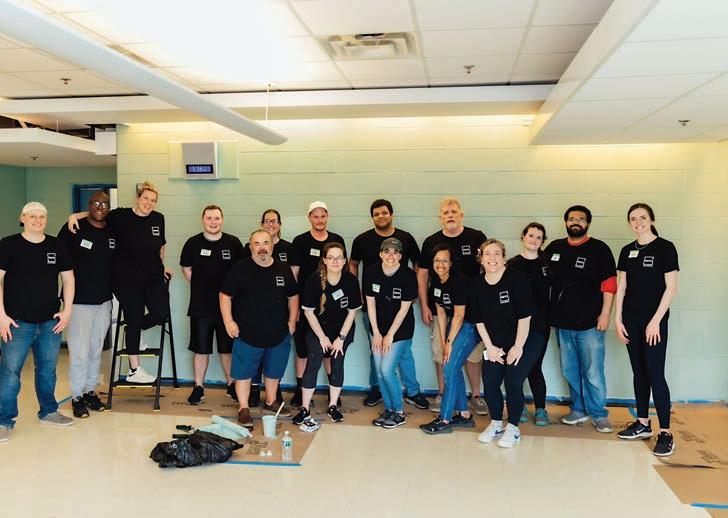
During Teacher Appreciation Week, the Hantz Foundation arranges food trucks, yoga classes, a cookie cart, and more. Above: Volunteers from Hantz Group assist with the lounge makeovers.

Foundation schedules daily treats focusing on wellness, from little things like chair massages, yoga classes, gift cards, and food trucks to big efforts like reorganizing classrooms and remodeling lounges.
“We really wanted to take Teacher Appreciation Week and blow it out,” Hantz says. This past year, efforts to remodel the teachers’ lounges at each of the schools required three months of planning, four days of hard labor, and 40 volunteers.
The Foundation also partnered with Home + Sort (see related story on page 2) to organize the spaces effectively. The end results were worth it, with teachers immediately gathering to work, eat lunch, and relax.
The Hantz Foundation is made up of a small staff. Michelle Benman specializes in event planning; Hussein Warmack focuses on outreach and community partnerships; and Lindsay Hurd supports marketing and operations. Former teacher Roxanne Turner has joined the team recently as the director of community outreach. Her educational background will be key to advancing the programming slate in the years to come.
Beyond them, it takes a village to serve the needs of the community, and the Hantz Foundation welcomes support (see sidebar).
The Hantz Foundation’s work on Detroit’s east side is a testament to the power of community-focused efforts. By supporting education and fostering community through events and programs, the Foundation is making a tangible difference in the lives of residents and the future generations of Detroit.
For Hantz, it all started with the vision of helping 1 square mile.









As you build wealth, you go through different financial stages. e call these stages the comfort levels.
It is remarkable what can happen when our clients take each stage to heart and build their wealth. They achieve financial success beyond what they ever anticipated. They have less stress in their lives because they aren’t worrying about how they are going to make ends meet. They have more time to spend on what they prefer to be doing.
Here, we lay out some focus points and strategies for each of the levels.
Level 1: Awareness
You’re building a foundation of good habits:
• ou’re establishing good saving habits, and your spending is under control.
• ou’re managing your debt.
• ou have an emergency fund so you are prepared to handle the unexpected, and you continue to build it so it keeps up with your financial position.
• ou have basic protection such as term life insurance.
• ou have a will, powers of attorney, a funeral representative, and designated beneficiaries. Simple trusts will need to be considered at this comfort level.
• ou’re diversifying your taxes to help minimize what you owe in the future. This could include a tax-advantaged retirement account, such as a oth I A.
• ou have home and auto protection with an umbrella policy to protect your earnings.
You’re staying alert and committed:
• ou are on track to pay off all your debt. To enter comfort level 3, you must be debt-free.
• ou’ve upgraded to permanent life insurance, making sure your human life value is covered.
• ou are taking advantage of taxpreferred investments to protect your portfolio from excessive taxation.
• ou are revisiting your estate planning document to adjust for changing net worth and gross estate growth.
• ou are regularly reassessing your risk, factoring in any changes (e.g., new drivers in the family or recreational vehicles), reviewing your umbrella coverage, and rebalancing your home and auto coverage as needed.
• ou are weighing risk with the ability to take a higher first-dollar risk in deductibles.
You are stretching your thinking and leaving your legacy:
• ou recognize that liability exposure becomes more important than replacing objects, and you are insulating yourself from anything that could pierce your net worth and threaten your legacy planning.
• ou continue to identify goals and develop strategies to achieve those goals while creating a personal family legacy.
• ou are continuing to weigh risk with the ability to take a higher first-dollar risk in deductibles.
• ou find yourself able to plan for future generations, and you rebalance legal documents accordingly, considering how you could impact the next generation and or a charity.
• ou are setting up survivorship life insurance policies for any children and or grandchildren who will receive parts of your legacy.
• ou are using unified credit through gifting strategies, tying it with advanced estate planning documents. Things to consider are philanthropy fit, the best tax leverage, and how to involve the next generation in the overall strategy.










BELIEVE IN ALL THINGS OTHERS SAY CAN’T BE DONE


Four team members find personal and professional growth acting out Hantz Group’s guiding principles

BY LAUREN WETHINGTON / ILLUSTRATIONS
BY
ANDY POTTS








AAs a company committed to the growth and success of both its clients and its employees, Hantz Group was founded on four guiding principles: Believe in all things others say can’t be done, What won’t happen under my watch, Know your resources and treasure them, and Enjoy the ride.
These tenets are intended to remind employees to be open-minded and innovative; to handle their clients’ financial futures (and the future of the company) with the utmost care; to nurture and expand on their natural strengths; and to have fun and create memories as they move through their professional journeys.




Although Hantz Group team members embrace all guiding principles on a regular basis, four shining stars from four very different departments caught the eyes and ears of their supervisors for their exemplary journeys within the company. Read on to learn how these professionals serve as embodiments of each tenet and how they have achieved success in their own unique ways.








When the COVID-19 pandemic hit Michigan in early 2020, Hantz Group senior soft ware developer John Arkins found his skills put to the test. Not only did the company need to digitize all operations quickly, but CEO and founder John Hantz also had an idea for a newer, faster loan-approval process. FastApp, a fully remote program, would allow clients to gain preapproval for a loan or life insurance by answering just 10 simple questions from their smartphones or computers.
“In a regular insurance application, … the underwriting part takes a long time,” explains Arkins, who has been a member of the Hantz Group team since 1999. “With FastApp, people are preapproved, and they do it on the website themselves. It has a speedier underwriting process, so things happen much quicker.”
Arkins’s team did what may have seemed impossible: They successfully developed a brand-new product during a world-pausing pandemic. Even better, they took the app from idea to launch in only five weeks’ time, aligning with the Hantz Group guiding principle of “Believe in all things others say can’t be done.”
“A lot of what I do is converting what people want into reality,” Arkins explains. “Because sometimes people who are not soft ware developers just know what they want to have happen they don’t necessarily know how it’s going to happen.”
Arkins’s ingenuity has played a critical role in the expansion and enhancement of Hantz Group’s line of digital products and services. From developing the Senior
“SOMETIMES PEOPLE WHO ARE NOT SOFTWARE DEVELOPERS JUST KNOW WHAT THEY WANT TO HAVE HAPPEN — THEY DON’T NECESSARILY KNOW HOW IT’S GOING TO HAPPEN.”
—JOHN ARKINS, HANTZ TECHNOLOGY SENIOR SOFTWARE DEVELOPER
ice President eport, the company’s fi rst-ever digital business dashboard, to craft ing custom user interfaces for Hantz Group Systems, Arkins has played a role in the creation of many different innovations during his tenure at Hantz.
Hussein armack, vice president of Hantz Technology, says Arkins’s dedication to helping clients and improving his own skills makes him a pillar of the company.
“John is always finding new ways to apply the latest technology to enhance the client experience in ways that have not been done before,” armack says. “His work is critical to how Hantz Group functions and how it continues to improve the way it functions.”

his big dreams for the company include introducing more cloud-based development and incorporating artificial intelligence into Hantz Group’s digital infrastructure.
These days, Arkins’s primary focus is implementing innovative new electronic signature soft ware, but
“Sometimes soft ware development is kind of like Taco Bell,” he says. “ ou’re rearranging the same ingredients to make a different thing.”
“WE’RE IN A VERY SERIOUS BUSINESS. PEOPLE COME IN AND THEY HAND OVER THEIR LIFE SAVINGS AND THEIR FINANCIAL MANAGEMENT, AND I TAKE THAT INCREDIBLY SERIOUSLY.”
—JOHN BEEBE, CFP ® , MBA, HANTZ FINANCIAL SERVICES, INC. SENIOR VICE PRESIDENT
John Beebe, CFP®, MBA understands the gravity of being trusted with something important. During his younger years when he was an all-state football player and a collegiate baseball player, that gravity meant countless hours spent practicing and refining his skills so he’d be ready to perform his role when his team needed him.

JOHN BEEBE CFP®, MBA
“I wanted to perform well, so I worked hard,” Beebe says. “ ou can’t just go do two hours of tee work and expect that to translate to immediate success. ou have to be working in the offseason you have to stay in shape. I don’t think our career is really any different. If you’ve been in the business for 10 years, for example, you’re not done. ou’re there to maximize your potential as an advisor.”
As senior vice president of Hantz Group’s Tri-Cities and Upper Peninsula regions, a role he’s held for the last 15 years, Beebe is trusted with a job arguably more serious than school athletics: the management of
his clients’ financial futures. His approach to his role with Hantz is just as laserfocused as his dedication to his college baseball team, invoking the Hantz guiding principle of “ hat won’t happen under my watch.”
“ e’re in a very serious business,” Beebe says. “People come in and they hand over their life savings and their financial management, and I take that incredibly seriously. Creating urgency around that issue for the people that work for me is not hard. I’ve got to be there to represent the clients, to represent the company. … And frankly, my team does a great job of it.”
Beebe’s approach has earned him a position with significant responsibility and scope. His region has over 5,000 financial planning client households across eight o ces that span from Mid-Michigan to the Upper Peninsula.
In addition to hard work and dedication, Beebe credits his success to the power of

constant and effective communication, both with his clients and with the advisors and professionals who work for him.
On the client side, Beebe says effective communication means diligently staying in the loop with each family’s latest financial plans and goals, which are constantly in flux.
“For example, clients whose o. 1 goal is to get their kids college educated when that time passes, there’s clearly going to be a reset because that priority is now behind them,” Beebe explains. “ hen you’re meeting with clients consistently, you’re gaining that subjective information along with objective data, and you’re going to get the best solutions for the client.”
ithin his team, Beebe says communication is just as important as it is with clients. As a leader, he aims to stress the importance of the big stuff especially regulatory compliance and continuing education for certified advisors while not sweating the small stuff, like vacation time requests.
“There’s a responsibility on the part of the employees to understand why they’re doing what they’re doing,” Beebe says, adding that “ultimately, if it’s something around compliance, training, or continuing education, they have to commit.”
Beebe’s approach matches perfectly with that second guiding principle, which stipulates that preserving clients’ financial values, helping them achieve their goals, and safeguarding their futures and the future of the company are the paramount priorities of Hantz Group advisors. Beebe’s dedication to the success of both his employees and his clients serves as a shining example of this tenet.
“I’m not doing anything wild,” he insists. “I’m just trying to constantly communicate how important what we do is to these families we’re representing and to the company we’re representing. If you do a good job at that, you’re not likely to get disappointed along the way.”

Alex Calderwood had no idea what was coming down the pike for him when he answered a call from his friend Vadim Chernyak one day in spring 2020. A senior in high school at the time and a passionate musician, Calderwood had been holed up at home because of the COVID-19 pandemic and was eager for a creative outlet. Chernyak had an interesting suggestion for one: Hantz Group, the company Chernyak worked for, was starting an internal web series and needed a drummer for the show’s band. Having jammed with Calderwood in the past, Chernyak thought he could be just the man for the job.
“So I showed up … [and] I brought my own drum kit from home; it was this 1950s jazz kit that was made from different parts of a really low-budget setup,” Calderwood remembers. “I had never done anything like
this, and none of the [Hantz Group] guys had done anything like this, so we were all sort of learning it together.”
Calderwood spent the ensuing four years dedicating many Wednesday and Thursday nights, as well as Friday mornings, to rehearsing and recording sessions for the Hantz Group show while attending college full time. Through his participation in and dedication to the project, he forged relationships with a large cast of Hantz Group professionals and absorbed a wealth of information about the world of financial planning.
“Sitting in the show and just playing the songs, listening to John [Hantz] and his guests talk, I was hearing all of these concepts that they were referring to within the financial planning practice,” Calderwood says. “I was noticing how much of an overlap they have








“A LOT OF SONGWRITING IS REALLY ABOUT ARTICULATING EXPERIENCES AND VALUES, AND I THINK THAT REALLY CARRIES OVER [TO FINANCIAL PLANNING].”


AND I THINK THAT REALLY CARRIES OVER



—ALEX CALDERWOOD, HANTZ FINANCIAL SERVICES, INC. PLANNING ASSISTANT AND DRUMMER
with music. … A lot of songwriting is really about articulating experiences and values, and I think that really carries over to financial planning .”
Although Calderwood did not study financial or economic subjects formally in college, his commitment to improving the show while growing his own knowledge and skill set in the process caught the attention of many movers and shakers at Hantz Group.
Calderwood had unknowingly demonstrated the company’s guiding principle of “Know your resources and treasure them,” which reminds team members to identify their existing strengths and expand on them in order to create new opportunities for themselves. For Calderwood, that new opportunity came in the form of a job offer following his college graduation in spring 2024.
“After one of the shows , John Hantz came up to me and was like, ‘If you ever want to work here, just let me know,’” Calderwood recalls. “I was like, ou know what I’d like to give it a shot.’”
While he still lends his rhythmic expertise to the show, Calderwood now provides a new kind of

backbeat in his role as a planning assistant for Hantz Group’s Ann Arbor and Southfield o ces. In his role, he helps keep those o ces’ operations humming like well-oiled machines.
“I’m providing, so to speak, the rhythmic foundation so that financial advisor Dave Seidel , our front man, can not worry about what’s going on behind him and just kick ass for the clients,” Calderwood says, adding that “I’m here to just keep doing the best work I can do. For the work that I’ve put in, I’ve definitely received the benefits back out.”

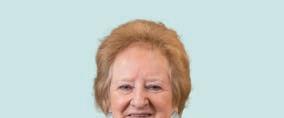
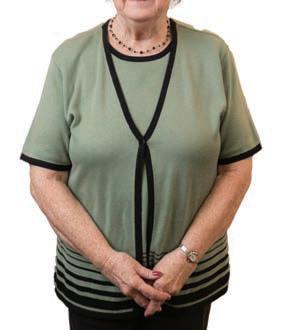
Growing up on a farm instilled the importance of hard work and determination in Angie Dammann. Her job today as the administrator of the Hantz Group o ce in Okemos requires plenty of hard work: Answering constantly ringing phones, supporting and assisting the o ce’s busy advisors, and handling client requests with a smile are just a few of her formal duties.
“I don’t just sit at my desk and answer phones and run the computer,” Dammann says. “I also intermingle with the clients. … If they need anything, I’m here to help them. ith the advisors, I am there, too.”
Dammann is a consummate professional in her administrative role, but what makes her so special is her commitment to making her o ce a warm, friendly, and joyful place to be for clients and employees alike. Every morning, she arrives early to brew coffee for the o ce, and she’s all too happy to pitch in on tasks such as cleaning and general o ce maintenance if it means things will run more smoothly for clients and advisors.
Even more than the coffee or the cleaning or the welcoming demeanor, it’s Dammann’s annual Christmas display that has made her something of a celebrity within the Hantz Group world.
“ ould you believe I had a client that came in today and could hardly wait till Christmas to come in and see the decorations? I still have four poinsettias in the lobby since [last] Thanksgiving,” Dammann says with pride. “That’s kind of a conversation piece right now; the clients just love it.”
Every year, Dammann and her teenage grandkids, Sean and Sara (who were just 7 and 9 years old when the tradition started), bring two carloads of Christmas trees, snowmen, and sparkling, festive goodies up to her Okemos o ce. They then spend an entire day decorating together, creating memories as they turn the lobby into a dazzling winter wonderland.
“They come on a Friday or Saturday, and we would decorate all day, then go to church and make it a family night,” Dammann reminisces. “A lot of compliments [came in] from the clients; they enjoy coming in here.”
One of those clients is Sue Burns, who says stepping into Dammann’s o ce during the holiday season is enough to turn a glum day into a jolly one. “It’s a fantastic display that dazzles the mind, … not overdone, not underdone,” she says. “It is outstanding!”








“IF [CLIENTS] NEED ANYTHING, I’M HERE TO HELP THEM. WITH THE ADVISORS, I AM THERE, TOO.”
— ANGIE DAMMANN, HANTZ FINANCIAL SERVICES, INC. OFFICE ADMINISTRATOR
egional Senior ice President Jeffery Soper points out that Dammann’s commitment to her annual Christmas display is a perfect example of “Enjoy the ride,” Hantz Group’s fourth and final guiding principle. The tenet encourages employees and clients to view everyday challenges not as pitfalls but as opportunities for creating growth, excitement, and new memories.
“Our clients and employees alike anxiously await the Christmas transformation that takes place every year. e have clients that come into the o ce during the holidays just to experience Angie’s Christmas wonderland,” Soper says. “She is not only our o ce administrator she is the caretaker of the o ce and those that work here. I think this is a definite example of Enjoy the ride,’ and she brings everyone else along with her ”
Even when she’s not decorating for the holidays, Dammann enjoys her work. She says she never goes home stressed out or with a headache because she genuinely loves being around her coworkers and clients. And if she has anything to say about it, employees and clients at the Okemos o ce will continue to enjoy her Christmas displays for many holiday seasons to come.
“Everybody says, ell, when are you going to retire ’” Dammann quips. “I’m not going to retire.”









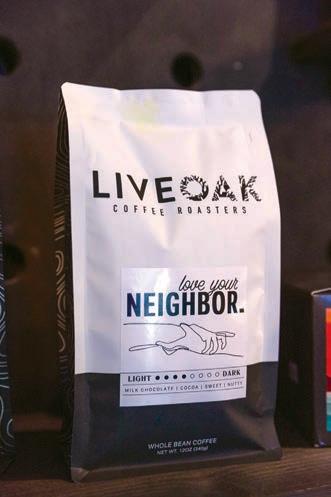


With help from Hantz, this Midland couple launched a collection of successful coffee shops that serve up community, connection, and — of course — delicious drinks
BY NICOLE FRESHEE MAZUR / PHOTOS BY BRAD ZIEGLER
ost people don’t get choked up when talking about their financial advisors.
But Renee’ Deckrow’s relationship with Hantz Group has played such a key role in her life that reflecting on it makes her a little misty-eyed. “I’m getting emotional just thinking about how awesome they’ve been for us,” she says. “They’ve gotten us through a lot of things.”


The “us” enee’ is referring to is herself and her husband, Aaron Deckrow. Together, the Midland-based couple own Live Oak Coffeehouse oasters, a business that spans four locations (an original in Midland, plus Bay City, Saginaw, and Freeland) and a wholesale roastery.








The Deckrows self-described “creative types” who admit that business acumen doesn’t come naturally say that becoming successful entrepreneurs would not have been possible without the support and guidance of their team at Hantz Tim and Erin Lemke, John anDenBosch, Jacob icol, and obert lun. “Being an entrepreneur is hard, but with this team, you know you’re not alone in it,” enee’ says. “There’s security in having people that care about our success and long-term sustainability. It helps us to be brave and keep doing the hard things.”



and playing a key role in revitalizing
Those hard things include, but are not limited to, purchasing a 16,000-square-foot building in Midland, launching the coffee shops, and starting a roastery that serves customers worldwide. Oh, and playing a key role in revitalizing an entire Midland neighborhood (more on that later).

















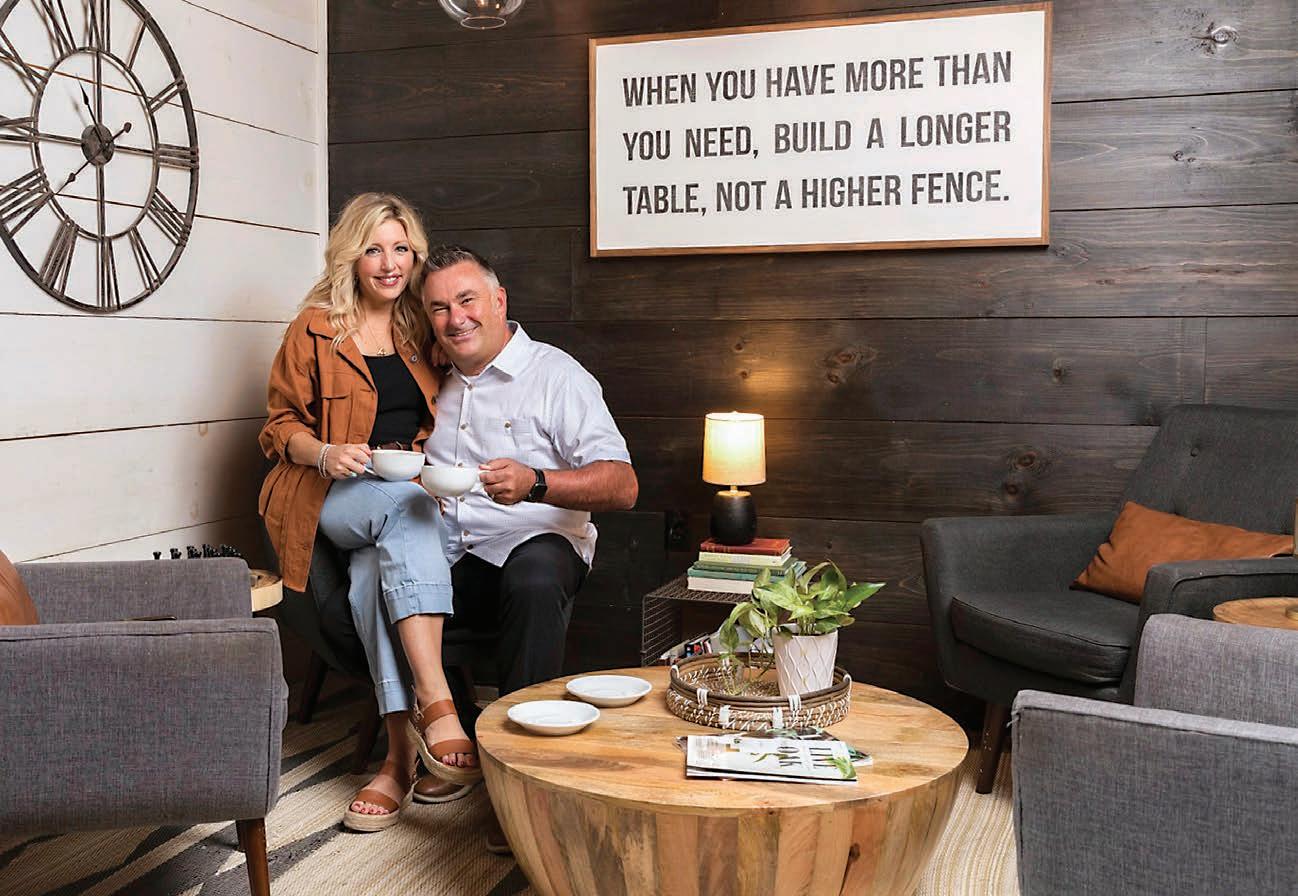













The Deckrows opened their first Live Oak location in 201 , but their partnership with Hantz stretches back nearly two decades to when the pair, who met and married as students at Michigan State University, were running their own photography business. (Aaron, a chemical engineer, was also working full time at Dow it’s still his employer today.)
As their business grew, the Deckrows needed to expand beyond their living-room studio, so they rented an o ce in a Midland building called Ashman Plaza. enee’, whose background in the restaurant business inspired her love of bringing people together, would often host events at the new space, and soon the need for an even bigger venue became clear. Around that time, Ashman Plaza came on the market. “Because we’d already had a heart for hospitality and creating community gatherings, we decided to go for it,” she says.


foot building with mostly vacant tenants was way out of our league,” Aaron recalls. “ e weren’t sitting on a pile of money, and we didn’t know how to come up with getting it.”
So, the Deckrows called Tim and Erin Lemke, whom they started working with in 200 . Together, they hammered out a business plan. “Tim helped me get my mind around where in our portfolio that money would come from and how it would make sense for where the real estate market was at the time,” Aaron says. True to Hantz’s holistic approach, the company advised on how to finance the building’s purchase and also provided business and property insurance. “Having that level of guidance allowed us to focus on the vision of the building,” Aaron adds.


proved easy thanks to their experience in the wedding industry, where much of their photography business was focused. ot long after the sale went through, Ashman Plaza became home to a spate of wedding-centric startups florists, makeup artists, an event planner, a bakery, and more. “The building was taking on a life of its own with all these entrepreneurs,” enee’ says. “ e were creating an incubator.”

But fi rst, the couple had to figure out how to pull it off. “Buying a 16,000-square-
At the time the Deckrows bought Ashman Plaza, opening a coffee shop wasn’t on the couple’s bingo card. Instead, they were focused on finding tenants, something that
The seed for Live Oak was planted when enee’ was hosting a celebration for the new businesses in Ashman Plaza. She was looking for a mobile coffee cart to cater the party, but she couldn’t find one so she had the idea to create her own coffee shop in the building. As luck would have it, a boutique on the ground floor had recently moved out, leaving a large, vacant space. “Something inside of me resonated,” says enee’, who had dreamed of owning a coffee shop ever since stepping into her first Starbucks. “ e love coffee and what it can do by bringing people together.”


“BEING AN ENTREPRENEUR IS HARD, BUT WITH THIS [HANTZ GROUP] TEAM, YOU KNOW YOU’RE NOT ALONE IN IT. THERE’S SECURITY IN HAVING PEOPLE THAT CARE ABOUT OUR SUCCESS AND LONG-TERM SUSTAINABILITY. IT HELPS US TO BE BRAVE AND KEEP DOING THE HARD THINGS.”
—RENEE’ DECKROW, OWNER OF LIVE OAK COFFEEHOUSE & ROASTERS




The Hantz team has seen that communityfocused spirit since the beginning: “Aaron and Renee’ are a couple that just make everyone around them feel loved,” Erin Lemke says. “They are genuine and fun and humble. They bring their strong faith, individual talents, and experiences to create a place where people can belong to something and achieve personal growth.”
The Deckrows weren’t coffee experts by any means, but they were OK with that. In the years since starting Captured Productions, they’d become students of business, working with coaches, attending conferences, and reading, in Renee’s estimation, “hundreds of books.” One crucial lesson they learned: “To build a sustainable business, you must learn to get things done beyond your own efforts,” she says. “Our aim was to empower our managers and baristas without presenting ourselves as the coffee experts.” The pair

intended to hire baristas and roasters along with a supportive team to strengthen the infrastructure, allowing them to concentrate on the broader vision.
But first, they needed guidance. After all, as Aaron puts it, “How do you get a business loan for a business that doesn’t yet exist?” There were a lot of startup costs, including buying large (and expensive) coffee-making equipment, and the Deckrows, who had four young children at the time, weren’t sure they’d have the money or time to invest. “To take on something like that,” Aaron says, “we needed support to help us with the ‘how.’”
Once again, Hantz was there to assist. Tim Lemke and his unique set of specialists walked the couple through their financing options, helping them use their equity in Ashman Plaza to fund the coffee shop a move that “dramatically increased” the
building’s value, Aaron says. “As a smallbusiness owner, I don’t have an attorney on retainer or a tax person in-house, so we need partnerships [like the one with Hantz] to help us interpret things and coach us through.”
Through all the challenges the Deckrows have faced funding Ashman Plaza, securing a loan for Live Oak, dealing with complex tax matters enee’ says their partnership with Hantz has inspired the couple to keep pushing forward. “Something I cherish about Tim is how [in so] many meetings he steps up to his whiteboard and calmly walks me through [things] because I continue to be anxious about how we’re doing everything and making sure everything is right,” Renee’ says. “I always leave our meetings feeling good.”
What’s more, she says, the personal touch that Hantz offers is indispensable. The
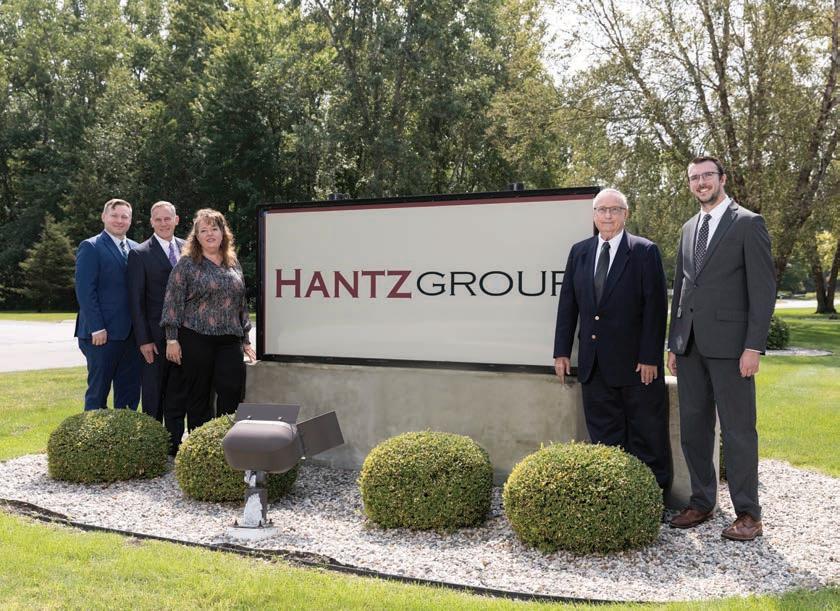
team members are always willing to pitch in wherever needed, whether it’s connecting the Deckrows with resources, offering a listening ear, or sending new customers their way. “They’ve cared about every part of the business,” Renee’ says. “They’re genuine partners in this journey.” The feeling is mutual. “We have been with Live Oak since the beginning,” Tim Lemke says, “and through helping them, we also have learned things that have enabled us to help other clients.”
Today, Live Oak is, true to the Deckrows’ vision, a community hub. The Midland location has become an anchor for Ashman Plaza, which is located in a neighborhood now known as Midtown. The moniker stuck thanks to the couple: “It didn’t have a sense of pride and place until we started that grassroots effort to call it Midtown,” Renee’ says. Since Live Oak opened, countless small businesses have moved to the neighborhood, which has drawn more young professionals. The Midland Noon Rotary Club, in partnership with the city, neighborhood entities, and local businesses, even revitalized the park across the street. “We were able to transform this area that was kind of forgotten,” Renee’ says. “It’s pretty
cool to think about what’s happened through the simplicity of coffee.”
Inside the coffee shop, entrepreneurs write business plans, nonprofits hold meetings, and artists showcase their work on the walls, which double as a makeshift gallery. Careers are launched. Community is built. Connections are made. “It’s called Live Oak because we wanted to create a space of shelter and respite,” Renee’ says. “Live oaks grow stronger because of storms. They’re durable. As they age, their arms grow down to the ground and create easy access to their care. Those are the values and principles we tried to create through our coffee shop.”
The second Live Oak location debuted in Bay City in 2019, a third followed in Saginaw in 2022, and a fourth opened in Freeland at the end of 2024. The Deckrows opened their roastery in 2020 in Ashman Plaza; they also operate a kitchen there that churns out everything from house-made syrups to quiche. To date, the couple employ around 50 people, and their four children, who range from 16 to 25, work in various roles in the company. Renee’ notes that faith, family, and friendship are the crucial ingredients of their success.
The Deckrows’ Hantz Group team consists of (from left to right) John VanDenBosch, Tim Lemke, Erin Lemke, Robert Klun, and Jacob Nicol.
As for the future, the Deckrows aren’t sure where their path will lead, whether it’s franchising their coffee shops, expanding their roster of wholesale partners (their beans recently became available on Faire, an online marketplace that connects independent businesses with retailers worldwide), or focusing on consulting for aspiring smallbusiness owners, something they also do. Whichever direction they choose, the Deckrows, like the team at Hantz, are focused on personal growth and everything that goes along with that thinking of new ideas, serving others, and enjoying the ride. “The common thread is helping people get started in a small and tangible way,” Aaron says. “That’s always been our mission.”
It’s the mission, too, of the Hantz team, whom the couple refer to as the “backbone” of their operation. “People go into a coffee shop and talk about the espresso machine or what beans they’re roasting, but they don’t often say, I wonder who their financial advisors are, or what kind of insurance they’re carrying, or what taxes they’re filing,’” Aaron says.
“They’re the unsung heroes of our story,” Renee’ adds. “Just like a plant needs support to grow, they’re a post we can be tied to as we’re growing. We know we’re not going to break.”
The testimonial included herein was provided by a current Hantz Financial Services, Inc., Premier Planning client. No cash or non-cash compensation was provided as part of this testimonial.
“PEOPLE GO INTO A COFFEE SHOP AND TALK ABOUT THE ESPRESSO MACHINE OR WHAT BEANS THEY’RE ROASTING, BUT THEY DON’T OFTEN SAY, ‘I WONDER WHO THEIR FINANCIAL ADVISORS ARE, OR WHAT KIND OF INSURANCE THEY’RE CARRYING, OR WHAT TAXES THEY’RE FILING.’”
—AARON DECKROW, OWNER OF LIVE OAK COFFEEHOUSE & ROASTERS


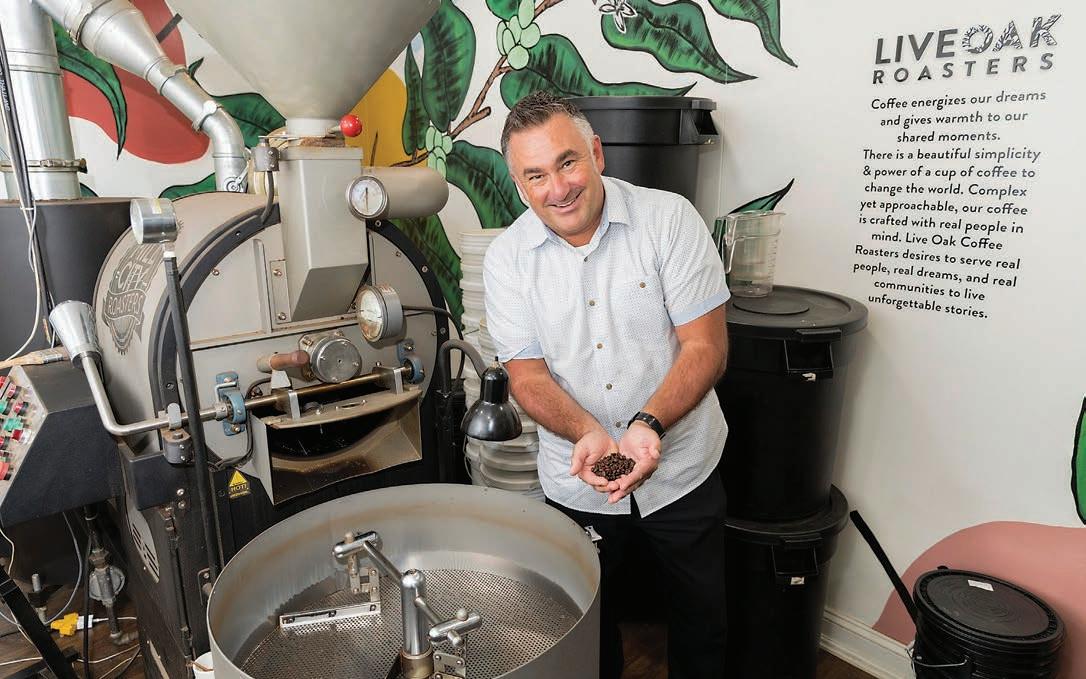

Coffee shop owner offers four tips for making the perfect cup at home
There are lots of ways to prepare your coffee, but Aaron Deckrow, half of the husband-and-wife team behind Midland-based Live Oak Coffeehouse & Roasters, likes to keep it simple: He makes his morning cup — Live Oak’s Midtown blend — with a Cuisinart grinder and a Mr. Coffee coffeepot. “My hack is setting the timer every night before bed so I


can walk downstairs in the morning and not think a single thought before I have my coffee,” he says. Here, he offers his tips for making the perfect cup at home.
1. Shop around. When it comes to finding what you love, sampling the lineup at your local coffee shop beats randomly picking a bag of coffee from the supermarket. There’s a difference between store-
bought and fresh coffee, Aaron says, and “the quality of bean that a coffee shop can offer is real.”
2. Grind as you go. Whole coffee beans maintain their freshness for a while, but once they’re ground, the clock starts ticking. “Ground beans absorb everything, so freshness and taste can change quickly,” Aaron says.

3. Weigh in. It may sound counterintuitive, but dark roasts (which tend to be smokier and more chocolaty) are less dense than light roasts (generally fruitier and more acidic). That means the same measurement of each may yield different results. For maximum consistency, Aaron suggests ditching your tablespoon and

instead weighing your coffee on a small scale.
4. Drink it with a loved one. This one’s a nobrainer. The Deckrows enjoy their morning coffee together every morning, with Aaron serving Renee’ her cup — a tradition they’ve had since their first child was born. Perhaps that’s the secret to staying married for almost 30 years?

“WHEN WE SAY THAT WE ARE NAVIGATING WATERS IN A PERFECT STORM, WHAT WE MEAN IS THAT THE INSURANCE ENVIRONMENT RIGHT NOW IS VERY CHAOTIC.”
—SHANNON MYERS, Ch FC®, MBA, CPCU®, PRESIDENT OF HANTZ AGENCY
BY JOHN RETZER / PHOTOS BY BRAD ZIEGLER
Aperfect storm has materialized over the insurance landscape.
Severe weather, rising repair costs, inflationary pressure, and auto insurance uncertainty have created an unstable and dangerous front.
“ hen we say that we are navigating waters in a perfect storm, what we mean is that the insurance environment right now is very chaotic,” says Shannon Myers, ChFC , MBA, CPCU , president of Hantz Agency. “The way that we review these policies has to be different from the past so that we can come up with new strategies. We are seeing what is happening in Florida and California, where getting insurance is very di cult if not impossible in some areas. e do not want to get to that point.”
In this insurance tempest, the Hantz team
believes its customers will be able to make better decisions if they understand the forces at work.
hile hurricanes in Florida and wildfires out West get the lion’s share of the headlines, the National Oceanic and Atmospheric Administration says there were 2 billion-dollar weather and climate disasters across the U.S. in 2023, and they cost more than $ 2 billion.
“Things that cause significant issues for insurance carriers normally do not affect Michigan and Ohio,” Myers says. “And because we don’t use the same carriers as, say, Florida, we normally don’t experience their insurance instability.”
In Michigan in 2023, however, there were three separate billion-dollar weather events.
“ hat is unique about this year and last is
what has caused the majority of the claims from severe weather,” Myers says. “ From January through June of 2023, we had 0 reported hailstorms.”
Damage from hail and other weather events has been on the rise in Michigan. Perhaps most notably, severe storms and multiple tornadoes in August 2023 wreaked havoc across the state. President Joe Biden declared the situation a major disaster in February 2024, unlocking federal funding in nine counties.
“Insurance companies use historical data to figure out what rates to charge,” Myers says. “Historically, they have reserved appropriately, but these crazy weather patterns we are dealing with are causing issues. ind and hail deductibles are very common in states like Texas and Colorado, and they are now becoming more common in other states like Michigan and Ohio because of last year.
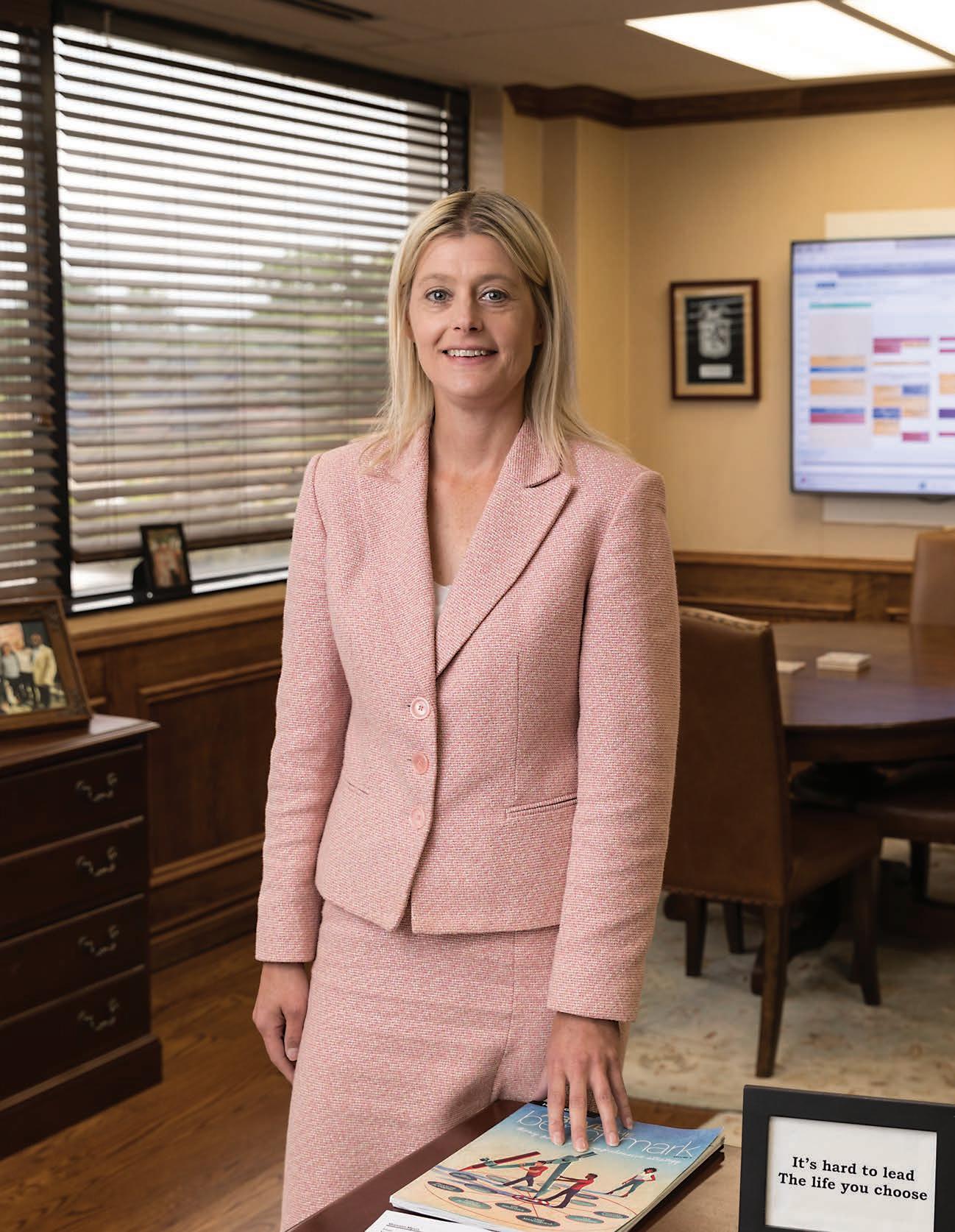
These deductibles tend to be higher than what a person would have as a normal all-peril deductible.”
As weather-related claims increase, insurance companies must raise their rates to remain profitable. Depending on the carrier, some homeowners are seeing large immediate increases; others are seeing small but steady escalations.
“One of the biggest things Hantz checks when we’re working with carriers is that their books are in line to cover major disasters,” Myers says.
The Automotive World Is Changing Auto insurance rates are going up as well for a few different reasons.
New car costs are rising steadily because of increased automotive complexity and electronic components. A typical new vehicle now has more than 30,000 parts and 1,400-plus computer chips. Indeed, electronic components account for 40% of a new car’s cost. Supply chain di culties that started during the pandemic have only exacerbated the problem.
As new car prices have risen, so has the price of used cars. Inflation, rising demand from budget-conscious consumers, and low inventory have combined to increase the price of used cars by 40 over the past five years. This has had a curious effect on auto insurance rates.
“Insurers use appraisals and estimates based on the average cost of a similar used vehicle to determine its value” Myers says. “Because the threshold now is higher, more cars are being ‘totaled.’ And that obviously adds to the amount that the insurance companies must pay out. In turn, that creates rate increases.”
As the industry shifts to electric vehicles, consumers can expect repair costs to rise
even more. The average EV costs 50% more to repair than internal combustion cars and trucks.
Shortages of skilled labor in repair shops compound the problem. Auto repair now is highly technical, increasing costs and the time it takes to get a car back from the shop.
Another factor to consider is Michigan’s 2019 auto reform, which brought sweeping changes to the state’s no-fault insurance landscape. Lawmakers, regulators, and insurers are still trying to figure it out.
“ e are five years into insurance reform changes, and while it has forced insurance companies to make changes, we do not yet know the longterm impact,” Myers says.
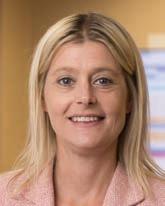
Shannon Myers ChFC®, MBA, CPCU®
The Michigan Catastrophic Claims Association is a good example of industry instability. The amount charged for the MCCA portion of auto insurance was reduced in the first year the law went into effect. In 2022, a refund of $400 per car was sent to drivers. That, however, created a deficit in the MCCA fund, which resulted in price increases in 2023–2024.
On top of all that, a 2023 study by the American Property Casualty Insurance Association found that despite fewer miles driven post-pandemic, claim severity for U.S. private passenger vehicle damage rose nearly 50% from 2018 to 2022, while the average bodily injury claim severity rose 40%. So along with the increased costs to replace a car, medical expenses and lawsuits are also contributing to the current financial situation.
Two generations have grown up in the U.S. without a visceral understanding of how inflation erodes purchasing power and wealth. After the Paul olcker led Federal eserve broke the severe inflation of the 1970s with two brief engineered recessions, Americans have grown used to low and predictable price increases.
In 2022, however, inflation reached a 40-year high, introducing new generations to the horrors of the irrevocable loss of purchasing power.
Predictably, inflation will increase insurance premiums as the costs of repairs and replacements rise. Home insurance premiums are poised for significant increases, as building replacement values over the last five years have gone up 44 . Home insurance rates, meanwhile, have gone up an average of 36%.
To stay ahead of the gathering storm, Hantz encourages its clients to take a holistic and proactive approach to protecting their property and families.
“It is all about managing risk transfer,” Myers says. “What do clients take on? And what do we want to move over to the insurance company to manage?”
A comprehensive review of insurance policies is necessary to ensure the right coverage is in place.
Managing your deductible is part of the review equation. “First dollar coverage” policies might seem like a good deal because there is a low deductible — or sometimes even no deductible — applied to a covered claim. However, these policies typically lead people to making small claims and having higher premiums. Carrying a higher deductible in today’s
“INSURANCE IS NOT MAINTENANCE. THERE MIGHT BE HAIL, BUT IF YOUR ROOF WAS 20 YEARS OLD, THE DETERIORATION OF YOUR ROOF IS PROBAB LY THE ROOT CAUSE OF THE DAMAGE. SIMILAR LY, YOUR CAR ACCIDENT MAY BE THE RESU LT OF WORN TIRES.”
—SHANNONMYER S , ChFC®, MBA, CPCU®, PRES I DE NT O F HANTZ AGENCY
environment makes more sense for managing risk in the long term.
When setting a deductible, Myers says, the questions to consider are “What is your pain point? What is the dollar amount below which you can manage the repair ” Often, it makes sense to carry a $5,000 or even a $10,000 deductible on a home insurance policy.
Searches for cheaper rates frequently will uncover that less expensive policies offer reduced coverage — the savings exist because something was taken out of the equation.
Myers advises strongly against dropping umbrella coverage or decreasing liability coverage to get a cheaper rate. And while moving to a less expensive policy with a different insurance company may seem financially advantageous, she notes that “right now is not an environment where moving carriers is something I would typically recommend.” That’s because “underwriting has become a lot stricter, with many carriers utilizing home inspections and other technology to identify adverse risks.”
In addition to home and auto policies, Myers says that umbrella policies warrant consideration. These policies offer liability coverage that extends beyond typical home and auto insurance, helping to protect against potential lawsuits for damage and injury.
Lawsuits are big business, especially in the wake of Michigan auto insurance reforms that ended mandatory lifetime care guarantees. Michiganders are bombarded with television ads and billboards that promise big lawsuit payouts in the wake of an auto accident, “slip and fall,” or other personal injury situations. Hedge funds now are investing in lawsuits in exchange for a percentage of the award.
According to the Insurance Information Institute, in 2009 the average personal injury
jury awards for premises liability and vehicular liability were $444,561 and $388,235, respectively. In 2020, those numbers were $811,769 and $2,673,427.
“Inflation has impacted lawsuits,” Myers says. “The average lawsuit has gone up, and the average costs of medical bills has gone up as well.”
While it is in fact true that insurance can replace lost or damaged property, a crucial part of avoiding catastrophic damage is doing routine maintenance.
“Insurance is not maintenance,” Myers says. “There might be hail, but if your roof was 20 years old, the deterioration of your roof is probably the root cause of the damage. Similarly, your car accident may be the result of worn tires.”
Rather than reducing coverage, taking on a risky policy, or changing carriers, Myers suggests that homeowners first take proactive steps.
“There are some preventative measures that a lot of our carriers give discounts for, such as water sensors and auto water shutoff valves that detect an uneven flow of water a warning sign of a leak,” Myers says.
Home upgrades such as a new roof, storm-safe windows, security alarms, and central fire alarms and sprinkler systems also can reduce insurance premiums.
“Insurance is supposed to make you whole again, not better off,” Myers says. “Making claims is one of the things we try to manage so that the premiums don’t move as aggressively up, especially in the perfect storm arena we are experiencing.”
In the end, Myers says, understanding the moving parts and what causes premiums to go up and down is critical in the current environment: “An educated client is a good client.”









BY DAN CALABRESE AND MICHELLE COHL ILLUSTRATION BY THE HEADS OF STATE
Debt may be a fact of many individuals’ financial lives, but that doesn’t mean carrying it comes without consequences. Given Hantz Group’s holistic approach to guiding clients on their fiscal journeys, the team has seen just about every level of debt in every conceivable form.
hile debt itself is neither a scandal nor a sign of failure, it does change things. Anyone who has to allocate a percentage of their income to paying off debt has less capital available for other purposes. ot only that, but people who pay only the minimum balance toward their debt won’t see their balance get much smaller each month. It’s hard to plan a celebration of becoming debt-free if the numbers suggest you’re inching not running toward financial freedom.
Hantz Group isn’t content to let its clients fall into that pattern.
Many financial firms have a familiar approach to debt They try to make it cost you as little as possible each month while maximizing interest expense. In the case of clients who are trying to make the balance of income and bills work out in their favor, the lower monthly payment may feel hard to pass up.
But that approach leaves a lot to be desired.
Carrying debt puts clients in a much less favorable position when it comes to the moves
they can make in their financial lives. Debt ties up capital they could be deploying more e ciently. It limits the resources they can use to take advantage of positive market conditions.
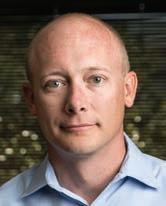
In contrast, debt-free clients have a much higher capacity for risk. They can absorb the impacts of inflation much better. They are able to pivot when they need to. They can afford to protect themselves better with higher levels of insurance. They have more capital to invest in the market.
The core of the Hantz Group philosophy when it comes to client debt is not to minimize monthly payments. It’s to find the most e cient path to becoming debt-free.
This is the basic concept behind an idea called “The Power of $100.”
As Christopher ay, chief lending o cer for Hantz Financial Services, Inc., explains it, “A hundred dollars can mean four or five years off your mortgage.”
The principle isn’t complicated, but it is a departure from the way many financial firms advise their clients.
Imagine having a mortgage loan totaling $300,000 at an interest rate of .5 . The
monthly payment for a 30-year mortgage would be $2,0 . If you pay only that amount for the full term of the loan, you will pay back not only the $300,000 but also more than $450,000 in interest.
So that home you think you bought for $300,000 is really going to cost you $ 50,000, and you’ll be dealing with that debt for three decades.
This is where the question comes in hat is the power of $100
If you can find a way to tack an additional $100 onto that monthly payment, it will take nearly four and a half years off the mortgage. So instead of making the payments for 30 years, you can pay off the debt in just over 25 years.
Hantz Financial Services, Inc., is a licensed mortgage broker in several states, including Michigan, Ohio, Florida, Illinois, and Texas. If you are interested in purchasing real estate in any of these locations, please speak with your financial advisor.
Hantz Financial Services, Inc. NMLS Number: 167864

Christopher Way NMLS Number: 1875280 26200 American Drive, Fifth Floor Southfield, MI 48034
248-304-2855
You will also save $70,000 in interest payments over the life of the mortgage.
But to take it a step further, what would be the power of $200? If the $2,097 monthly payment could become $2,297, the life of the loan could be reduced by seven and a half years. Now you’re out from under it during year 22. That’s an additional seven and a half years of your life you won’t be paying more than $2,000 a month to a mortgage lender.
What could you do with that money every month? Where could you invest it? What else could you pay off hat could you buy with cash that you might have otherwise financed
By the way, that scenario in which you add $200 to the monthly payment, and reduce the life of the loan by seven and a half years, also saves you $130,000 in interest costs over the life of the loan.
$130,000!
and 7.5% interest, which is quite a shock considering how long rates hovered between 2% and 4% prior to recent hikes.
“As we look toward the future and hopefully a lower-rate environment, we will look to refinance,” ay says. “If you’ve bought a house in recent months, you bought at 6% to 7%. We will look to reduce that rate as rates come down. If the rates come down from 7.5% to 7%, that saves you $100 a month. But now I want you to come up with another $100.”
“People who have always been in a 30-year mortgage have never seen the light at the end of the tunnel,” ay says. “But when they start working through these strategies, that changes. Now they get almost addicted to paying that thing off.”
“PEOPLE WHO HAVE ALWAYS BEEN IN A 30-YEAR MORTGAGE HAVE NEVER SEEN THE LIGHT AT THE END OF THE TUNNEL. BUT WHEN THEY START WORKING THROUGH THESE STRATEGIES, THAT CHANGES. NOW THEY GET ALMOST ADDICTED TO PAYING THAT THING OFF.”
—CHRISTOPHER WAY, CHIEF LENDING OFFICER FOR HANTZ FINANCIAL SERVICES,
INC.
You don’t have to dig back very far in American history to see the stark contrast between opportunities and outcomes for debt-free individuals and for debt-burdened individuals during a dramatic economic shift. Consider how debt was a factor in the way people dealt with the economic crisis of 2008. There was a complete meltdown of the mortgage market, and people whose debt was secured by the values of their homes suddenly found themselves underwater. They were struggling to make their payments; this was especially true if they had added a home equity loan to the original mortgage, since the market value of the home no longer approached what they anticipated when they borrowed against it. Many of these people had no choice but to default on their mortgages or to sell at a steep loss.
What could the average person do with that?
This is the power of becoming debt-free.
The adjustments necessary to go this route are not that cumbersome. Redirecting $100 a month would mean forgoing one dinner out for a family of three, or two Uber Eats deliveries for a couple.
This is one of the ways Hantz Group looks to move clients toward debt-free status.
Another is taking advantage of interest rates as they come down.
While interest rates have been historically low in recent years, they are currently slightly above the historical average of around 6 . Most people financing a mortgage today are paying between 7%
The Light at the End of the Tunnel
In other words, the Hantz Group team encourages borrowers not to treat refinancing as an opportunity to sit back and enjoy the lower payment that results from the lower interest rate. efinancing actually opens the door to eliminating debt faster since borrowers are paying less in interest.
The same mentality should apply to any other debt a client is paying off. Hantz Group advisors will look for opportunities to help clients increase their regular payments so they can get rid of the debt faster. This is where it helps a lot that the holistic Hantz team works together on a client’s complete financial life because among the various team members, there is a full understanding of the client’s financial picture and thus a good sense of how those strategies can be applied.
But those who were debt-free when the mortgage market melted were able to seize that opportunity. The price of homes collapsed, and those whose incomes weren’t dedicated to debt repayment could use the cash to purchase a house or even several at a steep discount. They could then sell that house at a higher price in the future. Bottom line? Debt-free individuals were better positioned not only to survive but to thrive during the 2008 crisis.
“It’s almost like, which end of the stick do you want to be on ” ay says.
Any way you look at it, reducing debt liabilities allows the positive aspects of your balance sheet to flourish. That’s why the Hantz Group team looks to move clients into debt-free status as quickly and smartly as possible.

A savvy interest rate strategy has saved one client more than $500,000 on mortgage payments
Debt management is often a matter of timing and strategy, especially when it comes to the process of taking out a home mortgage.
Jay Birchmeier, CPA, MSA, knows it all too well. He is one of the registered principals at Hantz, and he has coached clients through refinancing their mortgages in partnership with Christopher Way, chief lending officer for Hantz Financial Services, Inc., and two key members of Way’s team — Kelly Russo and Baily Bianchi.
Recently, Birchmeier had clients who were searching for their next home. Russo suggested they obtain a mortgage preapproval letter to act quickly if they found the right property. Her advice proved timely, as they soon discovered their dream home.
While the negotiation process was challenging, they managed to secure the house.
A significant hurdle arose, however: The interest rate on their 30-year mortgage was almost 4 times the rate they had locked in on their previous mortgage. Despite the couple’s initial hesitation and the temptation to walk away, the ideal nature of the home ultimately led them to proceed with the purchase.
So Way, Russo, and Bianchi helped them devise a strategy: They would take the 30-year mortgage at the higher rate and then watch interest rates closely and refinance when the rates came down. Six months later, interest rates dropped enough that they were able to refinance to a 20-year mortgage. While doing so bumped up the monthly payment and required a shift in day-today spending habits, it ultimately saved the clients more than $500,000 in interest payments.
“Kelly did a great job watching the rates long before that six months were up,” Birchmeier says.
And why stop there? The team is now watching rates for an opportunity to refinance to a 10-year mortgage — again, requiring a higher payment but saving even more in interest payments over the term of the mortgage.
“Ultimately, once this is paid off, the options they will have to fulfill lifelong dreams will be a lot greater and a lot less stressful than had they not been on this path,” Way explains.
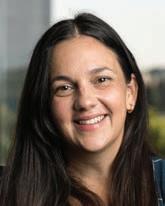


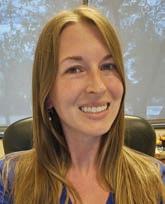

This example showcases the value of the holistic approach from strategy to execution — knowing the clients’ financial situation inside and out made it possible for the alert and ready mortgage team to act decisively when the right moment struck. Within six months of buying a home, the clients were able to take advantage of a much lower rate and take 10 years off their loan. As rates continue to drop, the holistic team will endeavor to remove an additional 10 years from the loan. They have been able to minimize the increase in payment by taking advantage of lower rates.
—Dan Calabrese and Michelle Cohl
The testimonial included herein was provided by a current Hantz Financial Services, Inc., Premier Planning client. No cash or non-cash compensation was provided as part of this testimonial.

It might feel gratifying to find out your financial advisor has found a way to reduce your monthly debt payments a little, but ay poses a question that speaks to something more powerful “How would you feel if you were debt-free ”
“It’s going to save them a massive amount of stress,” ay says. “And clients who focus on reducing their debt and becoming debt-free, even though they have a lot of wants, and even though they now have cash available to purchase those wants, they don’t depart from their cash very easily. They start hanging onto their cash.”
And beyond how you would feel, what would you do with the capital that was freed up That’s how the Hantz Group team views the question of debt when developing strategies for clients.
This article was written for the purpose of educating our readers. Examples used throughout this article offer simplified explanations for illustrative purposes only. Should you have any questions regarding debt management, debt consolidation, refinancing opportunities, or cash flow, please contact your financial advisor. Mortgage-related services are provided by licensed mortgage loan originators.




Here’s how the Hantz team works to stay ahead of modern-day scammers
BY DAN CALABRESE AND MICHELLE COHL / ILLUSTRATION BY THE HEADS OF STATE


The digital world is filled with possibilities that never existed for previous generations. It also is rife with unprecedented threats. And while financial scams are hardly a new phenomenon, the manner in which scammers target people is evolving quickly.
Just as businesses have to watch out for cyberattacks on their data and their operating systems, individuals with wealth to manage should be wary of being targeted by unscrupulous people presenting all kinds of phony propositions.
At Hantz Group, professionals stay up to speed on what to be looking for.








control through deception, intimidation, or undue influence of a specific adult’s assets or money.
Real Clients, Real Scams
Scammers know how to appeal to people’s hopes and fears, and that can make it challenging for advisors to help untangle these situations.
“ hen you want something to be true, you rationalize why it is the way it is,” ancket says.
The Hantz team has dealt with many scam situations in recent years. Here are a few reallife examples, with personal details omitted to maintain clients’ privacy.
•Romance Scam

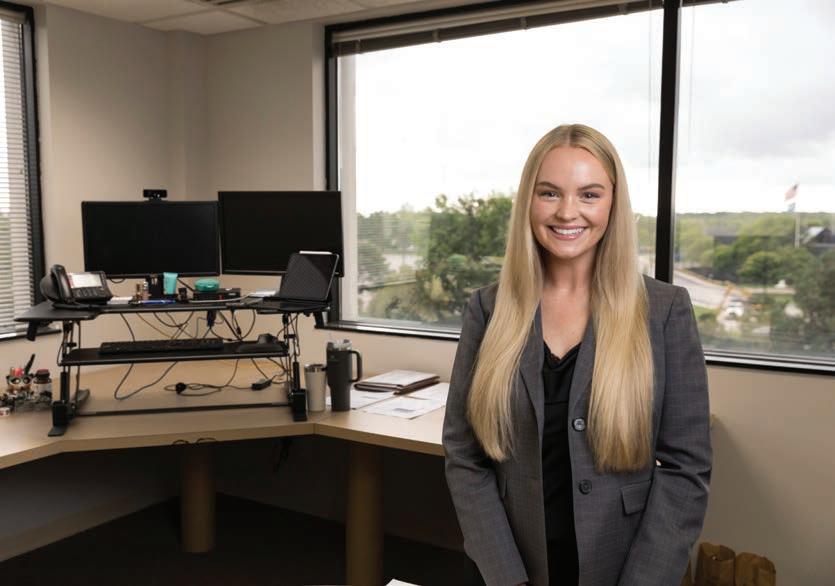
A recently widowed woman reconnected with an old high school flame, and they began corresponding regularly. Soon the old flame claimed to be on an oil rig, which he said was why he couldn’t get together with her in person. Since she had recently lost her husband and he had left her considerable wealth, she became an easy mark for the classmate, who convinced her that he and his colleagues could not complete their work on the oil rig unless she sent them some money. hen the Hantz team became aware of the situation, they explained to the client that such situations simply don’t work that way the operators of oil rigs don’t ask around for donations but unfortunately, the client continued to engage with the scammers and lost a lot of money.
•Prizes,Sweepstakes,andLotteriesScam
A client was contacted by someone claiming to be from Publishers’ Clearing House, who said she had won a substantial prize. But they told her that, before she could claim the prize, she had to pay the taxes on it in advance. This is never how it works. hen you receive money, you pay the taxes at tax time. ou don’t owe them up front. But the client took the bait and asked her advisor for withdrawals from her account. To make matters worse, when asked the reason, she said it was to invest in a startup business. She was so taken
in by the scam that she even sent the perpetrator jewelry, expecting it to be put toward her taxes on the supposed prize. Needless to say, this ended badly. She is now in her 70s and has to work for a living. To her credit, she has gone very public about what happened to her and is working hard to keep others from being similarly scammed.
•Prizes,Sweepstakes,andLotteriesScam
A client who works as a nurse was told there was a package waiting for her at the U.S./Mexico border. What was it? She was told it was a pallet containing $1 million, which was a reward for her for working as a nurse during the COVID-19 pandemic. But guess what: To get it delivered to her, she had to pay for a courier, and that would cost $100,000. She told her Hantz advisors about it, and they immediately started asking questions. Why didn’t she just rent a U-Haul and go get it herself? What courier costs $100,000? Is $1 million in cash even enough to require a whole pallet? (It’s not.) The team asked very practical questions designed to show the client this situation made no sense, and, of course, it indeed turned out to be a scam.
•PigButcheringScam
A couple wanted to spend some of their retirement play money investing in cryptocurrency. They had met a big shot who supposedly had already made millions investing in crypto, and the big shot was going to take their money and do the same for them. At first, they started taking small distributions first $2,500, then $5,000, then $10,000 — and then considerably more, until all their nonqualified money was gone. The Hantz team sat down with their client, who anticipated what the meeting was about and assured the team immediately that he was sure it wasn’t a scam. He even had an app on his phone that showed the account he had was with a legitimate financial institution. Except it turned out the app was fake and part of the scam. There was no such account at that financial institution.
“WE TRAIN OUR ADVISORS QUITE REGULARLY ON HOW TO IDENTIFY FINANCIAL EXPLOITATION AND HOW TO IDENTIFY DIMINISHED CAPACITY, BECAUSE THOSE ARE DIFFERENT THINGS.”
—RILEY WANCKET, CRCP, DIRECTOR OF COMPLIANCE AT HANTZ FINANCIAL SERVICES, INC.

To make matters worse, the fake app then claimed his account had been frozen because of “suspected money laundering” and that he would have to send them $400,000 to unlock it. The Hantz team was able to put a stop to this before it got worse, but this is the sort of thing that can happen when people want desperately to believe something that isn’t true.
unfortunately something that offers a quick fi x,” ancket says.
In any case, the Hantz team looks out for certain situations that signal a scam is underway. Here are some examples:
•A client is communicating with someone who claims to be out of the country or at sea (such as the “oil rig” story from before), and this is why they can’t talk on the phone or on a video call.
•Scammers will learn things about the victim and make them feel cared for. This usually happens before there is a request for money.
•The scammer will claim there is some sort of emergency or a medical situation. Usually requests like these will start small but get bigger quickly so that clients are soon requesting distributions of six figures.
•Scammers take advantage of people’s loneliness, which makes them prone to accept social media friend requests and chat requests.



What the Hantz Team Looks Out For Hantz advisors receive updated training and alerts on scams like these and many others on an ongoing basis. They often look for one of two things The first is the kind of financial exploitation evident in the previous examples. The second is signs of diminished capacity in a client, such as the inability to appreciate the consequences of their decisions or the inability to recognize goals and objectives.
People who have fallen for a scam typically make decisions that are not in alignment with their objectives or with what they have previously communicated to their financial advisors.

And while older people are often seen as easy marks, younger people can be far too willing to jump at what appears to be a quick financial fi x through media such as TikTok.
“In some of the cases I’ve seen in younger people, it tends to be the investment scams, which are promising high returns, or

•Scammers take advantage of the fact that older people may be dependent on others, which they may not like, and get them to jump at what appears to be the chance to increase their wealth — or perhaps to do something nice for someone else.
•Scammers are tricky. They will trick people into giving them information, maybe by starting a conversation with, “Grandma, I’m hurt!” The target might reply, “Is that you, Billy?” Now the scammer knows the grandson is named Billy.
The Hantz team pays attention to anomalies that might suggest something like this is going on — say, a client who has little or no history of distributions suddenly taking a series of them. And if there is evidence of an actual or a supposed scam, Hantz advisors will work closely with the compliance department to determine the
best path forward, which may include alerting the FBI, the Federal Trade Commission, and local police.
Working anyone through a situation like this requires tact and grace. Sometimes the client knows they have been scammed, and that conversation has to be calm and collected, with an emphasis on the client’s physical, emotional, and psychological safety. No one wants to feel any more shame from the situation, and Hantz team members are trained on that point.
“We constantly emphasize to them the importance of creating a space where their clients can engage in open and honest dialogue without fear of being judged and ridiculed,” Wancket says.
When a client does not recognize they are being scammed, advisors are trained to ask probing questions — not “yes” or “no” questions — designed to draw out information that will hopefully bring the client around to realizing what’s going on.
“How did this opportunity introduce itself?”
“Did you get input from anyone else? What did they say?”
“ ho will benefit most from this ”
“Is this transaction similar to previous decisions you’ve made?”
Scammers are often 10 steps ahead of financial advisors, and sometimes they’ve told the victim to come up with cover stories. They will tell their victims, “Some people will have a problem with you doing this, so here’s what you should tell them.”
It can be tough to break through that facade without coming across as aggressive, but good advisors owe it to their clients to do everything possible to get to the truth.
While the Hantz team is diligent about watching for fraud, anyone who is concerned about a loved one being scammed should look out for the signs as well. Here are some things you can do:
•Provide emotional support and a safe space for the victim to open up and be heard.
•Ask open-ended questions to encourage the victim to be forthcoming with information.
•Make sure the victim cuts off contact with the scammer immediately.
•Report the situation to law enforcement and the FBI-run Internet Crime Complaint Center. Keep any evidence of the scam as supporting documentation.
•To minimize further damage, encourage the victim to enroll in credit monitoring and change the passwords to their online accounts.
• otify the victim’s financial institutions.
•Talk about these issues on a frequent basis.
And stay vigilant to avoid becoming a victim yourself:


•End all communication with a scammer as soon as you recognize what’s going on.
•Search online for contact information of whoever is making you an offer. If this person has run scams before, others have probably posted information about them.
•Resist the pressure to act quickly. Scammers often use fear to create a sense of urgency.
•Don’t give out personally identifiable information, and don’t wire any information to unverified people or businesses.
•Don’t send money, checks, jewelry, or gift cards to unverified people. o legitimate business works that way.
•Be wary of answering unsolicited phone calls, mailings, or door-to-door service offerings, and be cautious when you are contacted by someone with an unfamiliar phone number or email address.
•Be wary of anyone requesting money, even if they claim to be from a reputable agency.
•If a criminal does gain access to your device or account, take steps immediately to shut them out. Let your financial institution know what’s going on, and immediately change your passwords.
•If someone tells you that your bank or financial accounts have been compromised, and that you must take a particular action to rectify the situation, call your bank directly to see if this is true. Do not use a number provided by the scammer. Look up the number of your local independent branch.


Financial fraud is hardly a new thing, but the fraudsters are always fi nding new ways to fool people. The Hantz team constantly keeps up on these scams so they can watch out for their clients. A well-informed client is the most likely to be safe from scammers.

“BASKETBALL TAUGHT ME THE IMPORTANCE OF TEAMWORK, COMMUNICATION, AND PLAYING YOUR ROLE — ALL CRUCIAL IN FINANCIAL PLANNING.”
—PAM WILSON, CFP ® , MBA, C h FC ® , FINANCIAL ADVISOR AT HANTZ


Hall of Famer applies basketball principles to her career at Hantz

When Pam Wilson’s coach inducted her into Northwood University’s Athletic Hall of Fame in 2021, he described the “Pam Vortex.”
“There are certain people you can tell stories about, and the next thing you know, an hour has gone by and you’re still talking about that person,” Jeff Curtis said of the basketball player. “That’s Pam Wilson. It’s her competitive spirit, her positiveness, and her personality.”
Wilson made a lasting impact on her alma mater by being disciplined, dedicated, and stepping up wherever she saw the need.
The same qualities have made her a leader at Hantz Group.
BY WENSDY VON BUSKIRK / OFFICE PHOTOS
BY BRAD ZIEGLER


“She was easily one of the most versatile players I’ve ever had the opportunity to coach,” Curtis said. “She played every single position on the floor for us and did extremely well. It didn’t matter what position Pam was going to find success.”

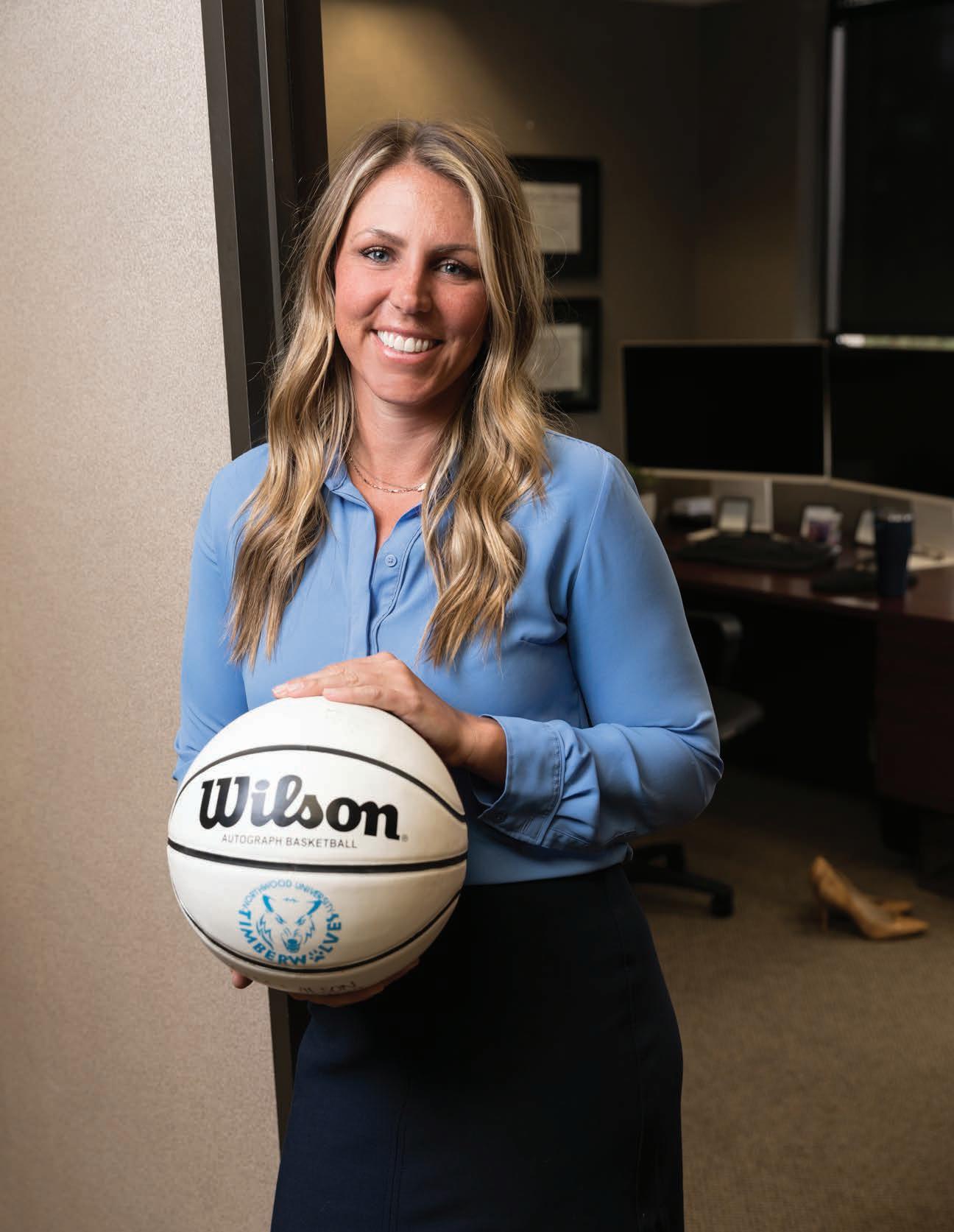

Pam Wilson has had a legendary basketball career that traces all the way back to the third grade. She still plays today, and she also has taken up golf.


Wilson began playing basketball in third grade. Influenced by her mother, who played basketball at Purdue University, and her father, who played football at ose-Hulman Institute of Technology, she was encouraged to embrace sports from a young age.
Although her mom had to drag her to her first practice, she soon warmed up to the game.
“I was very shy,” ilson says. “But once I got comfortable, I just wanted to keep playing with my friends.”
ilson played for the Grand Blanc High School Bobcats as well as travel basketball and
college showcases, where she was recruited by the orthwood Timberwolves. Over the next four years, she became one of the most decorated female players in orthwood’s history and the first to earn First Team AllAmerica honors, which are awarded to only 10 Division I players and 10 Division II players nationwide annually.
She credits adaptability and hard work as the keys to her success. “I wasn’t the most athletic, but I made up for it with hard work and versatility,” she says.
In 2021, ilson was inducted into orthwood’s Athletic Hall of Fame at a ceremony attended by her coaches, family, and teammates who flew in from across the country to support her. Coach Curtis talked about ilson’s dedication.
“Pam was always working on her game,” he said. “There were no off days for Pam ilson. She was in the gym constantly. She demanded that of herself and her teammates. Her leadership was off the charts.”
ilson earned athletic scholarships toward her bachelor’s degree in finance and her MBA at orthwood’s De os Graduate School of Management. After working as a coach at orthwood for two years, she was introduced to Hantz Group by a teammate’s friend.
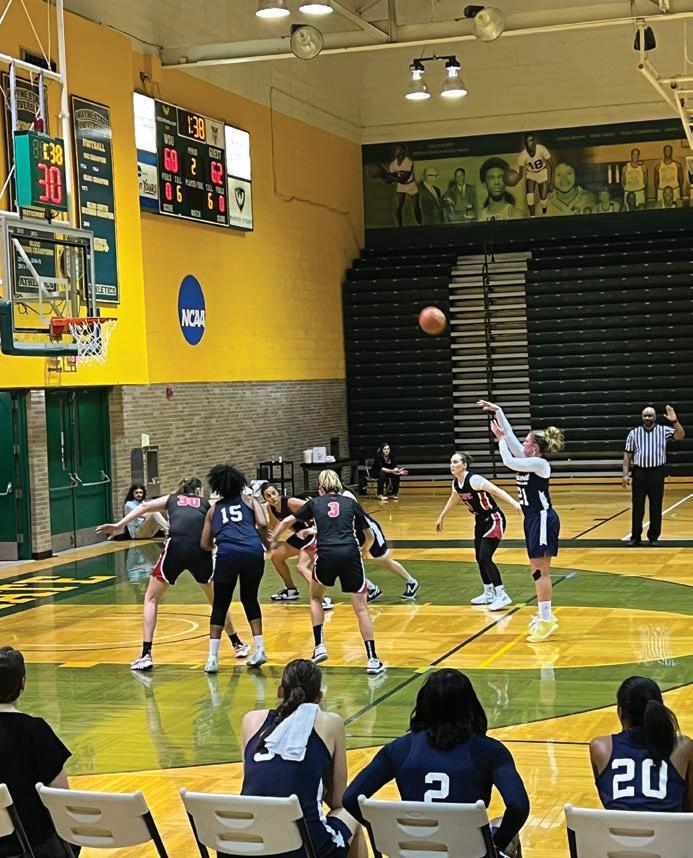

Whether playing basketball or working on financial planning, Pam Wilson uses the same strategies for success.
Work as a team: Just as a basketball team relies on each player, Hantz Group employs a holistic approach where every client is supported by a dedicated advisor and a team of specialists who handle various aspects of financial management, from investing to tax planning.

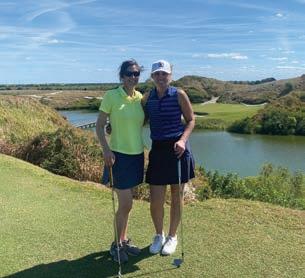

Think like a coach: As a team leader, Wilson mentors younger advisors, helping them develop their skills and build their practices. As a financial advisor, she helps coach clients to identify their strengths and weaknesses so they can take actions they
wouldn’t otherwise take to reach their full potential.
Have a game plan: Success depends on developing and executing a strategy. In basketball, this means preparing plays and adjusting tactics to outmaneuver opponents.
In financial planning, Wilson helps clients develop strategies to meet their goals, adapting to life changes and market conditions.
Know your plays: On great basketball teams, every player on the courts knows the plays inside and out. “If every player on the court knows what the other team members are doing during the play, they are better at adjusting when the defense changes or the play doesn’t

go as planned,” Wilson says. This holds true for the financial team at Hantz as well; every member of a client’s team is on the same page when it comes to helping that client achieve their financial goals. As the most important member of the team, the client needs to understand the plays, too.
Train hard: Just as athletes constantly train and refine their skills, Wilson and other financial advisors at Hantz Group pursue ongoing education and certifications, such as the CFP® and ChFC®, to stay current and provide the best advice to clients.
Challenge yourself: Wilson has never been afraid to step onto the court with
strong opponents. She recalls one-on-ones during high school with Mark Ingram, who went on to play football for the Alabama Crimson Tide, win a Heisman Trophy, and then have a career in the NFL. “I would play with these people that were way more athletic than me, but we had fun, and it made me way better,” she says.
Shoot for the win: Both basketball and financial planning require focus, discipline, and dedication. Whether she’s practicing free throws or analyzing a client’s portfolio, Wilson knows that success is achieved through consistent effort and commitment.
—Compiled by Wensdy Von Buskirk

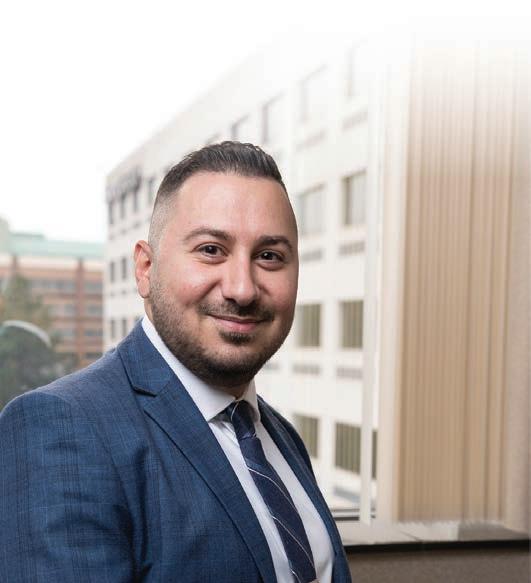


Taxes: Faris Dawood and Dave Johnston
Investments: Blake Smith
Legal: Zach Bialick and Jaime Fergus, both at Shea Law
Debt/Banking: Kelly Russo
Insurance: Jordan Cater




The name was familiar from Northwood’s Hantz Stadium, where football and track and field compete on the Midland, Michigan, campus. orthwood’s athletic director at the time, Pat iepma, put in a good word for ilson, and she was hired as a financial advisor.
ilson, CFP , MBA, ChFC , has been with Hantz Group ever since, rising through the ranks at the company’s Southfield headquarters. Today, she manages a practice with about 200 clients and leads a team of specialists, including a fellow orthwood basketball player who is an intern in ilson’s practice.
ilson sees many parallels between playing basketball and working at Hantz. “Basketball taught me the importance of teamwork, communication, and playing your role all crucial in financial planning,” she says.
She often draws on sports analogies to motivate her team and clients. One of her favorites is the “apple pie vs. mud pie” analogy.

“IN BASKETBALL, YOU CAN SPEND YOUR TIME WORKING HARD, GETTING SHOTS UP, OR JUST DRIBBLING AROUND WITHOUT FOCUS. THE SAME APPLIES TO FINANCIAL PLANNING: YOU HAVE TO SPEND YOUR TIME ON VALUABLE ACTIVITIES.”
—PAM WILSON, CFP ® , MBA, C h FC ® , FINANCIAL ADVISOR AT HANTZ
“Both tasks take the same amount of time, but only one has value,” she says. “In basketball, you can spend your time working hard, getting shots up, or just dribbling around without focus. The same applies to financial planning ou have to spend your time on valuable activities.”
hen she’s not at work, ilson still makes time for sports. She plays basketball in a men’s league at the Detroit Athletic Club and is actively involved in efforts to grow the women’s program there. She also enjoys golfing frequently with friends.
“Golf is a little bit easier on the joints, but it’s just as mentally challenging,” she says.
Despite her busy schedule, she remains committed to mentoring new advisors. She likens her role at Hantz Group

to that of a coach, helping others develop their skills and navigate their careers. Just like she did at orthwood, ilson sets the standard others aspire to follow.
“I was in the gym more than anybody. I got in more shots than anybody. It got to the point where my coach had to tell me, Pam, you need to go home,’” she says. “That’s where I’m at with my career. I’ve got a really good team, and we’ve got really good clients in our practice. I want to spend the time and focus on helping our clients grow and achieve their goals as well as helping my team grow their individual careers.”
Do you know a college student interested in a career in finance Hantz Group offers immersive summer and winter internships with the opportunity to gain real-life experience and securities and insurance licenses. This past summer’s program was the largest to date, with 14 interns at the Hantz Group headquarters in Southfield plus additional interns in other o ces.
To learn more, please visit hantzgroup.com/careers
“WE THOUGHT, ‘OK, HOW CAN WE TAKE SOME OF THE BENEFITS WE LIKE FROM MUTUAL FUNDS THAT ARE ACTIVELY MANAGED AND TAKE SOME OF THE BENEFITS WE LIKE FROM ETFS AND ACTUALLY COMBINE THEM TOGETHER?’”
—TONY NATALE, VICE PRESIDENT OF ASSET MANAGEMENT AT HANTZ FINANCIAL SERVICES, INC.
BY PATRICK DUNN / ILLUSTRATION BY THE HEADS OF STATE
While mutual funds have long dominated the investment world, exchangetraded funds, aka ETFs, have been growing rapidly. In the first four months of 2024 alone, the global ETF industry saw record net inflows of $46 . 6 billion, according to research and consultancy firm ETFGI. The ETF market is gaining a larger share of total fund assets; in fact, management consulting firm Oliver yman reports that this share will account for 24% of total fund assets by 202 , up 1 from 2023. While both mutual funds and ETFs offer managed pools of stocks, bonds, or other securities, ETFs have gained attention for their tax e ciency and lower costs. Hantz Financial Services, Inc., is working to make ETFs even more appealing with its American Drive Model Portfolios, or ADMP, a brand that brings a thoughtful,
active-management approach to ETFs.
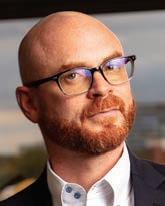
Tony Natale
Most mutual funds are actively managed by fund managers, who personally select the securities that will be included in the fund. Most ETFs are passively managed, meaning their performance is pegged to a major index, such as the S&P 500. But actively managed ETFs, like ADMP, are on the rise, accounting for 22% of all new money into ETFs last year and receiving $26 billion in inflows in ovember 2023 alone.
“ e thought, O , how can we take some of the benefits we like from mutual funds that are actively managed and take some of the benefits we like from ETFs and actually combine them together?’” says Tony
atale, vice president of asset management at Hantz.
The result, launched in October 2023, was ADMP. atale says ADMP stands alone in the financial industry as a fully transparent, globally diversified ETF-model portfolio that uses multiple investment firms.
“We went and picked best-of-breed investment managers to go create their respective strategies in an ETF-wrapper format so that we could build a model portfolio around it,” atale says. “ e partnered and collaborated with other thought leaders in the financial industry.”
ADMP’s unique approach offers benefits for investors of varying needs. atale says clients at all three of Hantz’s defined comfort levels “are finding their own value proposition” in the model. For those at comfort level 1 clients who are just learning to manage their











money and set financial goals atale says ADMP offers a financially accessible investment product, and ADMP is in fact built particularly with these clients in mind. For these clients, atale says, ADMP is a way to “build good habits.”
“It might be $50, $100, or $150, but they’re just getting used to the concept of something coming out of their biweekly paycheck to go towards savings and start creating that muscle,” he says.
For clients at comfort level 2 those who have built a strong financial foundation and have a healthy level of worry about being able to build their wealth and avoid debt ADMP may be a good way to diversify and optimize their portfolios.
“They’re doing it so they can legitimately start to save for something, whether that’s a purchase of a home, a car, or saving for college,” atale says. “They are traditionally trying to systematically save for a goal with some sort of outcome.”
Clients at comfort level 3 are debt-free, advanced in their lives and careers, and have the freedom to refocus on big purchases and leave a legacy.

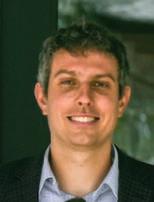
helped clients more easily understand where their money is located, as well as what the strategy is for each account,” says achel Doutsas, a financial advisor in Ann Arbor. That kind of straightforward visibility is not always easy to achieve, especially when clients have many accounts and corresponding strategies to reach their specific financial goals.
Another benefit, regardless of a client’s comfort level, is the reminder of the strength
ADMP offers a variety of advantages over both mutual funds and other ETFs. One of these advantages is transparency. hile mutual funds usually don’t disclose 100 of their holdings until the end of each quarter, atale says ADMP securities are designed to be “fully transparent all the time.” This means that investors can access a complete list of ADMP holdings whenever they want, which is especially beneficial since ETFs can be traded throughout the day as prices change as opposed to mutual funds, which can be ordered just once a day.
ADMP also offers the opportunity for greater diversification in your investment. Many ETFs are market cap weighted, meaning that they assign a higher allocation to securities with higher market capitalizations.


atale says most Hantz clients at this comfort level are interested in investing in ADMP “just because they can.” For example, if a client at this comfort level has paid off a mortgage, it may make sense for them to maintain the discipline they showed with that mortgage by putting what would have been their mortgage payment into ADMP. (See “The 3 Comfort Levels” on page 14.)
“They’re open to it not being excessively complex,” atale says. “As they’re shifting out of complexity, at a 10,000-foot view, they’re seeking simplicity.”
Indeed, ADMP’s simplicity has been a common point of appreciation among clients who have incorporated the model into their investment portfolios. “It has







“The reality of it is your portfolio, if that’s all you invest in, is more tilted towards the top 10 stocks,” atale says.


He adds that ADMP is “diversified without being overly diversified.” That is, it’s diversified based on asset class, including domestic stocks and international stocks with large, midrange, and small market capitalizations. The ADMP model focuses on the quality of investments rather than the sheer quantity.

of the team behind the work. “It’s not only me making the allocation,” notes Garrett Turner, a senior vice president and financial advisor in Clinton Township. “I get to share more about the work Chris Geczy chief investment o cer for Hantz Financial Services, Inc. does around the capital market expectations.”


“If the S P 500 is 500 stocks, and you own supposedly an active strategy that has 300 stocks, in our opinion, it’s a little disingenuous to say you have 300 best ideas,” atale says.
Another ADMP advantage is the model’s rebalancing strategy. The asset management group at Hantz rebalances the ADMP portfolio on an annual basis, and they also rebalance it throughout the year based on how financial markets evolve over that time. The Hantz asset management group will rebalance clients’ portfolios any time their
“WE WENT AND PICKED BEST-OF-BREED INVESTMENT MANAGERS TO GO CREATE THEIR RESPECTIVE STRATEGIES IN AN ETF-WRAPPER FORMAT SO THAT WE COULD BUILD A MODEL PORTFOLIO AROUND IT. WE PARTNERED AND COLLABORATED WITH OTHER THOUGHT LEADERS IN THE FINANCIAL INDUSTRY.”
—TONY NATALE, VICE PRESIDENT OF ASSET MANAGEMENT AT HANTZ FINANCIAL SERVICES, INC.
equity drops by 5% or more. On the other end of the scale, if the market has a lot of upward direction, Hantz staff want to allow that momentum to continue. They also work to make sure that it doesn’t happen so excessively that it significantly changes the risk profi le of clients’ portfolios.
“If you have our model that’s 60% equities and 40 fi xed income, and it gets past a 0 equity threshold and 30 fi xed income, we

The tradition of ringing the bell at the New York Stock Exchange (NYSE) dates back to 1 2, when traders banged a gavel to start and end the day. In February 2024, the Hantz Group team was invited to ring the bell for the closing of the NYSE to celebrate the launch of American Drive Model Portfolios (ADMP).
will rebalance the portfolio back to 60/40,” Natale says. “We would argue that even though there’s a lot of upward momentum, which you want, the model portfolio is actually starting to change its risk profi le.”
ADMP, like most ETFs, also offers greater tax e ciency benefits on taxable accounts compared with mutual funds. Mutual fund investors take on a portion of the capital gains taxes incurred when their fund manager sells a particular security. This can cause a problem for investors, known as a “phantom gain,” if the fund is selling a security at a profit but the security has lost value since a particular investor has bought into the fund.
“The investors have not always gotten to participate in all the benefits of their mutual fund that have happened on a historical basis, yet they do have to now own a portion of the capital gains distribution that’s happening,” Natale says.
However, Natale says, that situation traditionally does not happen with an ETF because of the way ETFs are distributed. As a result, ETFs are a lower-cost investment and traditionally more tax-e cient than a mutual fund.
“There’s a debate of which performs better: active or passive investing. And the reality of it is that they each have periods of time where they outperform relative to the other,” Natale says. “However, from a nonqualified basis, these phantom capital gains distributions can make a big difference on the decision.”
Hantz’s investment management group is the architect of the innovative investment product that is ADMP. Natale says Hantz staff carefully chose investment managers to build the product they wanted. When it comes to rebalancing and diversifying portfolios, Natale says the asset management group makes its decisions based on a sense of “high conviction” about the best choices for Hantz clients.
“A lot of our investment managers operate to where they truly do pick their best ideas, which means that their portfolios usually range within 30 to 40 stocks, sometimes as high as 50 to 60,” Natale says. “They’re saying, ‘I might have a benchmark, and the benchmark might have 500 holdings in it. But I’m going to pick the 50 best out of the 500, as opposed to the 300 best out of the 500.’”
It’s this combination of standard ETF advantages, an active-management style, and a thoughtful approach from investment managers that can make ADMP a wise choice for clients of all comfort levels.
“Everyone else is saying, ‘What’s out there? I’ll just use what’s out there,’” Natale says. “We’re saying, ‘We want to use these investment managers, and we’re working with them to build what we need them to build.’”
The team isn’t stopping with ADMP: Innovation is a priority at Hantz, so clients can look ahead to even more tailored investment opportunities in the future.
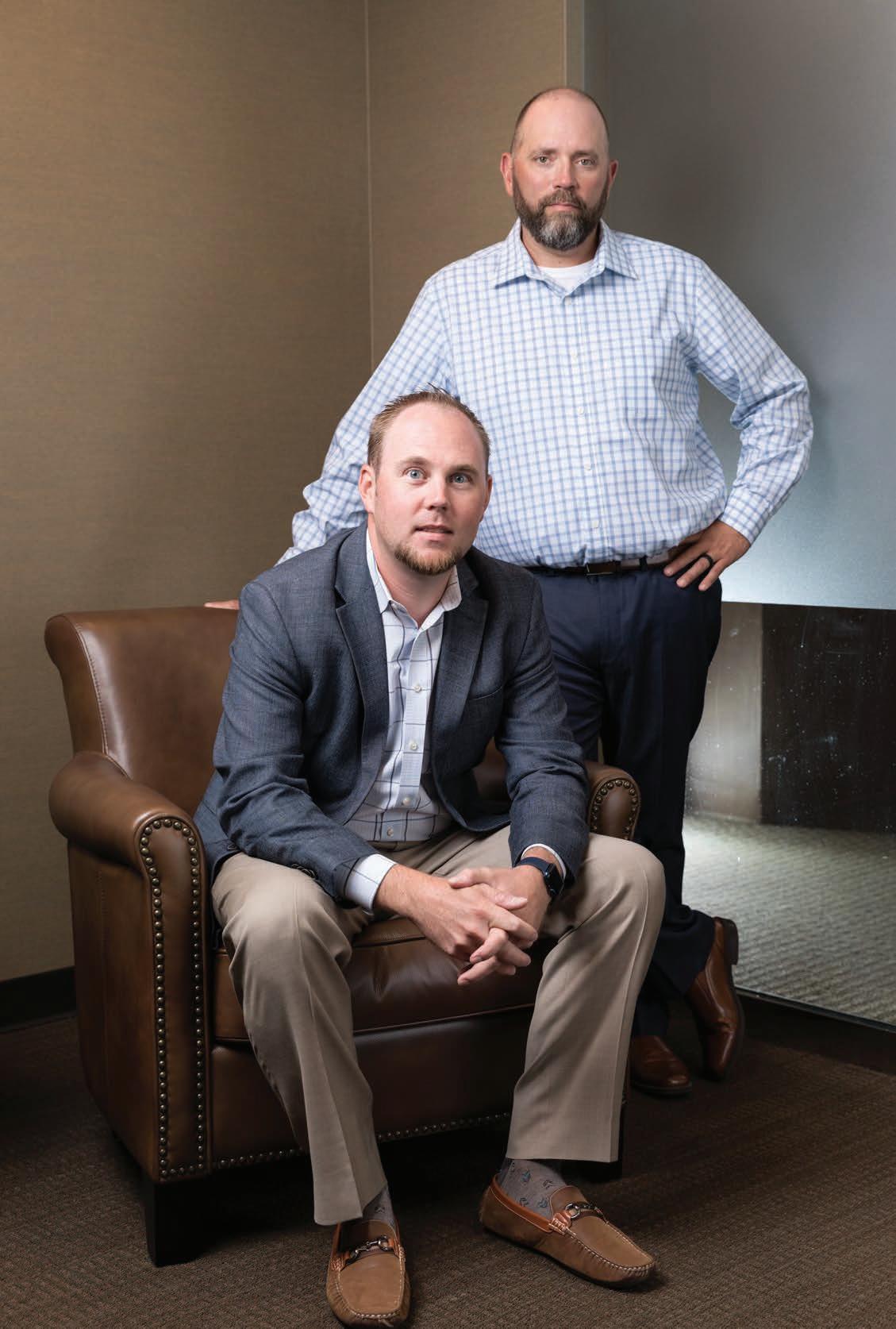
“[PEOPLE NEED TO] RECOGNIZE THEIR VALUE. IF THEY WERE TO DIE UNEXPECTEDLY, WHAT IS THE FAMILY LOSING? I DON’T THINK PEOPLE REALIZE WHO THEY ARE, THE TRAJECTORY THEY’RE ON, AND WHAT THINGS ARE GOING TO LOOK LIKE DOWN THE ROAD, HOW AMAZING IT’S GOING TO BE.”
—ANDREW SCRIVER, FINANCIAL ADVISOR AT HANTZ FINANCIAL SERVICES, INC.
BY PATRICK DUNN / PHOTOS BY BRAD ZIEGLER
When you think of life insurance, you probably think of a policy that provides financial security for your loved ones in the event of your death. And while you’re not wrong, Hantz Group financial professionals will tell you that’s just one of the many benefits of having a life insurance policy.
“It’s actually way more than that,” says Brad Wancket, Hantz’s director of insurance. “That’s only a quarter of why we really do these policies.”
Life insurance can also provide the policyholder a tax-free savings option, an opportunity to save for retirement, and even a private pension. Wancket says the policy’s death benefit is only a “wrapper” for these other benefits.
But taking full advantage of your life insurance requires an unconventional way of thinking and decisionmaking. That’s where Hantz’s holistic approach comes in. Life insurance is just one piece of a person’s financial puzzle, and the Hantz team wants to make sure it’s fitting with all the other pieces to form the best, most complete picture. Here’s how that might play out and what clients should consider along the way.
When you’re planning a life insurance policy, the crucial first step is not to underestimate what you’re worth to your loved ones. hen Hantz financial advisor Andrew Scriver works on life insurance policies, he says his biggest challenge is ensuring that clients “recognize their value.”
“If they were to die unexpectedly, what is the family losing?” he says. “I don’t think people realize who they are, the trajectory they’re on, and what things are going to look like down the road, how amazing it’s going to be.”
Understanding all that involves not just taking stock of current income and job benefits but also estimating what Scriver describes as the policyholder’s “human life value” — their future net worth based on their current career path. Once you get a full understanding of these factors, you’re more likely to want to protect your human life value. Scriver compares making decisions on a life insurance policy to insuring a car. You would not buy a $70,000 car and insure it for $20,000. If you totaled the car, you would not want to have to make up the $50,000 loss. The same goes for human life value: You want to make sure you are properly covered for the correct amount of life insurance based on your comfort level.
“If a family loses a spouse that has a $7 million value, and only $1 million or $2 million is protected, that’s a massive loss,” Scriver says.
Making decisions about a life insurance policy requires looking ahead and considering what you want your life to look like down the road.
“We want to try to position our clients in a way that their money is protected now and in the future,” Scriver says.
Life insurance is an opportunity to take charge of what your future looks like in myriad ways. One of those is saving for the future in a legally tax-advantaged or tax-free manner. Death benefits paid from a life insurance policy are not taxed, and withdrawals up to a cost basis or loans from life insurance usually aren’t either. If you have a permanent life insurance policy (which covers your entire life rather than a set term of 10 or 20 years), this means you could be earning interest and taking advantage of the savings while you’re still alive without having to worry about taxes on your earnings.
Non-Cash Value
“Short Game”
•Group Term Replacement
•Basic Need
•Human Life Value
“Irons”
*Tax-Free Income*
•Cash Accumulation for Retirement
•The Bank
•Disability Insurance
•Long-Term Care
“If you’re going to be worth 5, 6, 10, or 20 million in your life, what do you want that 5, 10, or 15 million to look like?” Scriver says. “Do you want it to be all dollars that are taxed? Or do you want to have a large amount of that money that you saved and worked hard for protected in taxadvantaged, tax-free vehicles?”
It’s important to make that decision and establish your life insurance policy early in life rather than amassing a considerable net worth and suddenly trying to convert it to tax-free status. Scriver describes this as “the courage to chase growth versus

•Single Premium
•Education Funding
•401(k) vs. VUL
•Private Pension
•Leverage/Legacy Policy
•Fully Funded Policies & Reallocate
•Strategy on Kids
•Children
•Children Gifting
•Grandchildren
•Grandchildren Gifting
•Uninsurable
Placeholder Rebalance Wrapper Rebalance

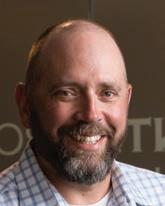
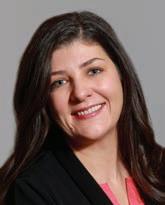
security.” For example, if you put $10,000 into your life insurance policy, $1,000 to $2,000 of it may cover your death benefit, but the other $8,000 continues to grow significantly over time.
Scriver says he doesn’t see enough people using their life insurance in this way. And if you start saving early, the benefits as you age can be immense. A life insurance policy can provide considerable tax-free retirement income, even acting as a kind of private pension.
“You can build an amazing portfolio that has a lot of insulation, and a lot lower risk from a tax standpoint, and have a much better financial life for you and your family while protecting your value along the way,” Scriver says.
The life insurance products and strategies that make sense for you will vary depending upon your age, life circumstances, and comfort level. Scriver and Wancket use the analogy of clubs in a golf bag to illustrate this concept, comparing differing life stages and comfort levels to short game, irons, and woods.
Short game represents comfort level 1, usually occupied by younger individuals or those whose primary focus is on protecting their noncash-value basic needs. Useful insurance strategies for them could include group term life insurance, disability insurance, or long-term care coverage. These strategies protect the policyholder in case of an emergency while also serving as a placeholder for needs later in life.
“By the time you need insurance, you’re generally older, because your health deteriorates,” Wancket says, “and so setting up and taking advantage of these different strategies at a younger age is really just going to benefit you as you go down the road.”
In the “clubs in a bag” metaphor, irons represent comfort level 2 — a more challenging game. This comfort level is where individuals who are more established in their lives and careers find themselves at this stage, they’re beginning to think about how to protect their human life value. For these individuals, cash accumulation for retirement is a key goal. Useful strategies for them may include establishing a permanent life insurance policy weighing the benefits of a 401(k) versus a variable universal life insurance policy or considering a long-term care insurance coverage offered by Hantz through Nationwide.
“Ultimately, what we’re trying to do is get them to have their basic need covered with permanent insurance, and then at least half of their human life value with a term policy,” Wancket says.
The final category in the “clubs in a bag” metaphor is woods. Woods are arguably the most challenging golf clubs to use, but they also allow for the longest-range hits, which is why they represent comfort level 3. Individuals at this comfort level are well established in their lives, usually older, and seeking to protect their legacy for their loved ones. Useful strategies for them may include taking out a policy on two individuals that doesn’t pay out until both of them pass away or taking out a policy on children or grandchildren. ancket emphasizes that strategies are still available to leverage up your estate or improve your tax positioning even if you’ve become uninsurable yourself.
As you consider which life insurance strategy is right for you and your comfort level, Hantz brings to the table numerous forward-thinking strategies that provide an advantage over what other financial advisors may offer. Hantz’s holistic approach means that your decisions about life insurance will be considered in the broader context of your
“SETTING UP AND TAKING ADVANTAGE OF THESE DIFFERENT STRATEGIES AT A YOUNGER AGE IS REALLY JUST GOING TO BENEFIT YOU AS YOU GO DOWN THE ROAD.”
—BRAD WANCKET, DIRECTOR OF INSURANCE AT HANTZ FINANCIAL SERVICES, INC.
financial picture. Hantz also offers easy-touse proprietary technology such as Hantz’s FastApp, which streamlines the insurance application process, and the Family O ce app, which lets you easily stay up to date on your finances.
That last point bears repeating: In addition to offering a broad range of products that are already on the market, Hantz staff are working to create new and innovative product ideas that better suit Hantz clients’ needs.
“ e’re building front-end technologies, specifically with the product companies, that literally no other carriers have in the industry, that are being built specifically for clients,” Scriver says.
Brooke Miller, regional life consultant for ationwide, has been working with Hantz since 201 . She describes Hantz’s FastApp as “one of the most unique, innovative, client-friendly things that I have ever seen,” making applying for insurance “as easy as ordering stuff off of Amazon.” Miller says that a “family dynamic” between ationwide and Hantz helps to continually improve the service.
“We have a strong partnership, which has allowed us to integrate Nationwide’s processes with the Hantz Group’s processes to create seamless and client-friendly interactions,” she says. “This enhances our ability to help clients, protect more families with life insurance, and put the clients in a better position overall.”
ith custom-made tools such as FastApp at hand, Hantz is uniquely qualified to help you understand your value and create a secure life insurance strategy that will benefit you and your loved ones for years to come.
Scriver puts it best: “The reason you hire the Hantz Group, in the end, is the innovation.”

—JONATHAN MEEKER, CPA, EA, PRESIDENT OF HANTZ TAX & BUSINESS


“WHAT YOU SAVE IS MORE IMPORTANT THAN WHAT IT DOES. IF YOU SAVE $1,000 [ONE TIME] AND YOU EARN 10%, YOU’VE GOT $1,100. THAT’S GOOD. BUT IF YOU SAVE $500 A MONTH , YOU’LL HAVE A LOT MORE TO WORK WITH.”

Clients at different “comfort levels” will have different tax-related priorities
BY DAN CALABRESE AND MICHELLE COHL / ILLUSTRATION BY THE HEADS OF STATE


Finance may boil down to numbers, but it really isn’t just about the math. Finance is intricately linked to the personal lives of individuals and their families. This is what makes tax planning more personal than purely mathematical and why it requires more than cold, hard logic.
If you think about the spectrum of tax planning, there are three standard deviations to the scope and scale of tax planning in a person’s life.
The first is a big personal change the start of a marriage, the birth of a child, the death of a loved one, a new job, retirement, or some other major life event.



The second is a change to the economy, which overlays the fi rst category. Expansion or recession? High or low interest rates? Bull or bear market? These changes can impact your tax planning.



Compounding those issues is the third deviation: a legislative change, such as the pending 2026 expiration of the Tax Cuts and Jobs Act of 201 .
Each of these three deviations plays an important role in a person’s life, and they influence the way clients deal with what Hantz Group refers to as the three comfort levels Awareness, orry, and onder.
People at comfort level 1 — Awareness — are getting a sense of what their current financial situation is. As part of that process, they should familiarize themselves with the fringe benefits they receive from their employers and how they can best capitalize on these pieces of their compensation. Do they understand the full implications of their flexible spending accounts, their health savings accounts, their 401(k) accounts, and their life or disability insurance?
Employee benefits are tax breaks built into your compensation package, so you need to be aware of how they can serve your interests. Over time, they can add up which raises questions about tax diversification and whether it’s better to deal in pretax funds (which you save today and pay taxes on tomorrow) or after-tax funds (which you first pay taxes on and then invest).
One might describe the tax treatment that accompanies an account as a “tax wrapper.” Depending on the wrapper, you can have the same amount of savings but very different outcomes.
The strategies you put in place early on to build your net worth can have a huge impact on your progression through the three comfort levels. Along the way, there is something critical to remember: Consistent, systematic saving is key to making any wealth-building strategy work.
“What you save is more important than what it does,” says Jonathan Meeker, CPA, EA, president of Hantz Tax Business. “If you save $1,000 [one time] and you earn 10%, you’ve got $1,100. That’s good. But if you save $500 a month, you’ll have a lot more to work with.”
The second comfort level is orry. It’s only natural to think about these questions as your financial situation matures over time Do I have enough to retire Can I help my kids pay for college Can I leave a legacy behind
This is where tax-preferred investment wrappers grow in importance. Separately managed accounts (SMAs), exchange-traded funds (ETFs), and cash-value life insurance because of the favorable tax treatment of each can help to assuage some of that worry.
At this comfort level, worry might be constructively channeled into a decision to do some rebalancing, possibly correcting an earlier allocation that didn’t quite hit the mark. oth I A conversions are one example changing insurance portfolios from term policies to permanent policies and using loss-harvesting strategies in nonqualified portfolios are others. And, of course, getting rid of debt always helps.


Worry may also bring the realization that tax planning impacts other people, which can lead to exploring tax-wise charitable giving as well as gifting to children and grandchildren through mechanisms such as Roth IRAs, 529 plans, and life insurance funding.
Comfort level 3 is Wonder, which might be put into words like this: “I wonder what kind of legacy I can leave, and what good I can do, without having the IRS get an undue share of what I’ve built.”
This “wonder” should lead to strategies that protect your portfolio from excessive taxation and reduce income tax liability for yourself and your heirs — think aggressive dequalification tactics such as Roth conversions.
“Clients in the onder phase often have the epiphany that it’s not their net worth that counts but their gross estate,” Meeker says. “The net worth is only relevant when you think you’re going to spend it all. When you realize you’re going to leave some of it behind, estate planning becomes an essential focus of tax planning.”
Estate planning considerations at this comfort level include life insurance trusts, inheritance/investment trusts, charitable trusts, and advanced trusts such as spousal lifetime access trusts (SLAT) and grantor retained annuity trusts (GRAT).
“As we go through our financial journeys, true tax planning is always present, from when we’re born to when we pass,” Meeker says. “It will only become more present because of the taxing problems we face concerning tax laws in this country.”
While individual Hantz clients can do little to influence tax laws, they can do a lot to be prepared for what’s coming in their own lives, and that’s what Meeker and his tax planning team emphasize every day.

Planning is more important than ever with potential shifts in the tax code on the horizon
BY DAN CALABRESE AND MICHELLE COHL
Changes in America’s tax laws are coming. Because of the way the existing laws are structured, that’s a given, which complicates the
imperative of tax planning. So how do you plan for your taxes when no one knows what the laws will be in the near future or the long term?
It’s a taxing problem, to be sure. It helps to understand where we are and how we got here.

Jonathan Meeker, CPA, EA, president of Hantz Tax & Business, explains that the U.S. tax code has changed constantly over the course of its history, and the American people have had to do their best to adapt to its changes. Sometimes we know in advance that changes are coming, and that is the case now because of the impending expiration of a critical piece of legislation passed seven years ago.
“No tax laws are permanent, so planning becomes paramount,” Meeker says. “Planning for tax diversification and tying it all together is within your control. What’s not in your control is what Congress passes. But there is a lot we can do with prudent, dynamic, holistic planning.”
The U.S. income tax was established in 1913 with the passage of the 16th Amendment. Prior to that, the government raised tax revenue through measures such as property taxes and sales taxes. Over the
years, income tax rates have varied widely. The highest rate at first was only . At one point, the highest rate was a jawdropping 4 . Today, the marginal rates range from 10 to 3 .
But that’s based on the Tax Cuts and Jobs Act of 201 , which is set to expire by 2026 unless Congress extends it and the president signs the extension. No one knows if that will happen, or if Congress will replace the act with something else, or if it will let the rates revert to what they were in 201 .

If that third option happens, there will be some serious shocks in store for taxpayers:
•The child tax credit will be cut in half from $2,000 to $1,000.
•The qualified business income deduction, which allows business owners to deduct up to 20 of their qualified business income, will go away, resulting in an instant tax hike for businesses.

•The alternative minimum tax exemption will fall from $1 million back down to $200,000, hitting a large number of taxpayers with a new tax liability.
•People who got anywhere from a 5 to a 50 reduction in their taxes back in 2018 — mostly small-business owners with families — will see that reduction eliminated.
•The estate tax threshold will drop from $13.6 million to a likely $ million, meaning everyone whose estate is valued between $ million and $13.6 million


will be no longer exempt from the tax. (Often there is little sympathy on this one because the tax is on very wealthy families, but keep in mind that those who inherit the estate have to pay the tax in cash even if the estate consists entirely of nonliquid assets.)
The constant adjustments of the estate tax threshold the value of anyone’s estate that is exempt from the estate tax combined with the impact of inflation make it di cult to anticipate what might happen as far as tax planning.

“NO TAX LAWS ARE PERMANENT, SO PLANNING BECOMES PARAMOUNT. PLANNING FOR TAX DIVERSIFICATION AND TYING IT ALL TOGETHER IS WITHIN YOUR CONTROL. WHAT’S NOT IN YOUR CONTROL IS WHAT CONGRESS PASSES. BUT THERE IS A LOT WE CAN DO WITH PRUDENT, DYNAMIC, HOLISTIC PLANNING.”
—JONATHAN MEEKER, CPA, EA, PRESIDENT OF HANTZ TAX & BUSINESS

“ hen the Tax Cuts and Jobs Act passed in 201 , the threshold was $5 million with an inflation factor built in,” Meeker says. “So in 201 , it doubled to $10 million and kept the inflation factor. The result is that the estate tax threshold in 2024 is $13.61 million, and in October they will announce the threshold for 2025.”
But without congressional action, the situation will change drastically in 2026.
“It is scheduled to revert back to $5 million plus inflation,” Meeker says. “That was a generous number historically, so $5 million plus inflation was fantastic. Then it doubled and left inflation on it. So cutting it in half is still very generous historically. And it generates very little revenue only about $32 billion in the context of a $5 trillion revenue base.”

based on most economists’ opinions. The current budget picture has us raising close to $5 trillion a year in taxes and spending roughly $6.5 trillion, which means we’re adding between $1 trillion and $2 trillion to the debt every single year. e’re getting close to the point where we’ll spend more every year paying interest on the debt than we will spend funding the military.
“ ight now, we have historically low tax rates with historically high spending,” Meeker says.

The Ticking of the Debt Clock hat to do about the pending expiration of the 201 tax law will be and should be one of the most critical questions for the new president and Congress. They will almost certainly have to figure it out in the 2025 calendar year.
And this all comes against a very di cult budget and debt backdrop.
The U.S. national debt now stands at roughly $35 trillion, while our entire gross domestic product stands at close to $2 trillion. That puts debt at roughly 121 of GDP, which is not sustainable,
Meanwhile, the distribution of the tax burden is lopsided, with 50 of taxpayers (above a median income level of $4 ,000) paying . of total tax, and the 50 under that median paying only 2.3 of total tax.
Something has to give, but no one knows what or how it will work.
Meeker’s perspective helps keep Hantz Group clients focused Plan wisely for what you can control, and do your best to be prepared for what you cannot.
Tax diversification is a good defense against an uncertain legislative future. Taking advantage of tax-e cient investments, which allow the investor to keep more of their returns, is also important. Tax-free assets provide insulation from tax erosion on a retirement nest egg’s spending power. A oth I A, a oth 401(k) 403(b) 45 (b), and a life insurance savings plan are all good examples of tax-free assets.

There are plenty of other tax management techniques to employ as well, such as optimizing your tax bracket, paying taxes at a controlled rate today instead of at an unknown rate tomorrow, and using tax credits and tax-wise deductions smartly.
At Hantz, all of these strategies are considered in the context of a client’s complete financial picture to set them up for success.




Mastering your finances goes beyond crunching the numbers
BY PARIS GILES / ILLUSTRATION BY THE HEADS OF STATE


“WHAT WE’RE HELPING [CLIENTS] DO IS ALIGN THEIR BEHAVIOR WITH THEIR GOALS, AND THEIR GOALS WITH THEIR VALUES.”
—DOUG LENNICK, BFA, CFP®, AUTHOR, AND CONSULTANT




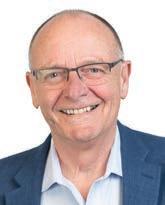
Forward-thinking, financially conscious individuals are sure to swoon over tales of paid-off mortgages, early retirement, and leisurely golden years free from money woes. Charming lore, no doubt, but is it all too good to be true The philosophy at Hantz Group is that happily ever after is attainable when advisors and clients collaborate with the understanding that financial savvy is as much about what you feel as it is about what you know.
Hantz Group consultant, author, behavioral financial advisor, and CFP Doug Lennick believes that emotional competency and financial intelligence are intertwined. That is, self-awareness is what will help you uncover your values, and those values are what should inform the behaviors that will help you meet your financial goals. Simply put, a client’s values, behaviors, and goals should be aligned throughout the financial planning process.


Lennick isn’t alone in that belief: Research also has shown consistently that behavioral coaching is one of the most significant services a financial advisor can provide for their clients to help them reach their long-term goals.
Lennick is the longtime mentor of Hantz Group founder and CEO John Hantz. In fact, each month, the entire team is invited to engage in a podcast hosted by Lennick, Hantz, and Senior ice President Mike eid that focuses on emotional competency. The team at Hantz Group believes that for clients to achieve their financial ambitions in the smartest way possible, both advisors and clients should aim to be emotionally intelligent.
High emotional intelligence is marked by the ability to perceive, understand, and manage emotions and use them effectively to relieve stress, communicate, empathize, solve problems, and quell conflict. Self-awareness is key to emotional intelligence and, ultimately, positive financial progress.
Consider what Lennick calls the health wealth connection. The way he explains it is this Financial stress decreases emotional competence, which can increase irrational behaviors and decision-making, which can decrease overall mental and physical health. “Emotions will frequently mislead one when it comes to financial decision-making,” Lennick says. Those bad behaviors can run the gamut, from an ill-advised trip to the mall explained away as “retail therapy” to a lavish wedding that plunges the newlyweds into debt.
Lennick adds that we shouldn’t take selfawareness and emotional intelligence for granted it all takes work. “Most people overestimate how aware they are of themselves,” Lennick says. “Practice makes permanent. hatever one repeatedly thinks, whatever one repeatedly does, gets wired into the habit center of the brain. And we want to make self-awareness a habit.” He encourages clients and anyone, really to employ what he calls the “freeze game,” which entails asking yourself these questions throughout the day hat am I thinking hat am I feeling hat am I doing Could I be thinking or doing something better



“I THINK OF FINANCIAL INTELLIGENCE AS THE ABILITY TO MAKE SMART, RESPONSIBLE, VALUES-DRIVEN DECISIONS WITH OUR RESOURCES AND OUR LIVES. IT’S ALIGNING BEHAVIORS WITH WHAT REALLY MATTERS.”
—DOUG LENNICK, BFA, CFP®, AUTHOR, AND CONSULTANT

“What we’re helping [clients] do is align their behavior with their goals, and their goals with their values,” Lennick says. “My values are family, happiness, wisdom, integrity, service, and health.” In keeping with the values of family and wisdom, Lennick and his spouse decided they would make it a point to fund their daughter’s education. Values are deeply personal, but if a client shares similar ones, then perhaps it makes more sense to open and fund a 529 plan or a similar college savings account than to take an expensive vacation every summer. But if traveling and experiencing new cultures as a family is one of your values, then maybe that fancy European trip is absolutely worth it. Or maybe you value both education and travel? It’s crucial not only to identify your values but also to position them in order of importance. If you can only do one, which represents what you care most about?
Lennick is also the CEO and co-founder of think2perform, a consulting firm that helps individuals and businesses improve their decision-making skills and performance using a values-first model. If a client isn’t quite sure where their values lie and wants to figure it out, think2perform’s alue Exercise may be a good place to start. It’s an interactive, digital game of sorts that prompts users to sort 51 cards stamped with topics including money, health, integrity, power, freedom, and faith into a “keep” or “discard” pile. From the “keep” pile, participants are asked to whittle their values down to the top 15, the top 10, and, eventually, the top five. The idea is to get clients to differentiate the things they kind of care about from the things they really care about and, as a result, hone in on the values that are at the core of who they want to be and how they want to live.
Taking inventory of self and identifying values is only useful if a client then uses what they’ve learned about themselves and their goals to inform their behaviors, and that’s why Hantz advisors include behavioral coaching in their bevy of tools. According to a recent Vanguard report,
incorporating behavioral coaching into the financial planning agenda has the potential to add up to 2% of value to a client’s portfolio over time. Hantz advisors guide clients toward smart financial decision-making and effective wealth management by encouraging the processes already discussed: self-analysis, emotional awareness, and values-based goal setting. Behavioral coaching is most useful in times of uncertainty, like when the market is volatile or when personal circumstances are leading to financial stress. Hantz advisors teach clients to move deliberately and with clarity and confidence.
of a person’s life — their taxes, investments, insurance, and so forth — shouldn’t be managed in isolation, because every piece affects the others. Instead, they should be viewed together so that clients and their advisors can see the big picture and establish the smartest financial strategy that accounts for all elements at play. Factoring in the emotional side of money is an important part of this approach.
Hantz Group advisors are more than just numbers-crunchers and market analysts, and they encourage clients to join them in considering the human quirks that
“MOST PEOPLE OVERESTIMATE HOW AWARE THEY ARE OF THEMSELVES. PRACTICE MAKES PERMANENT. WHATEVER ONE REPEATEDLY THINKS, WHATEVER ONE REPEATEDLY DOES, GETS WIRED INTO THE HABIT CENTER OF THE BRAIN. AND WE WANT TO MAKE SELF-AWARENESS A HABIT.”
—DOUG LENNICK, BFA, CFP®, AUTHOR, AND CONSULTANT
Lennick notes that the tendency to trade the well-being of our future selves for immediate gratification is a strong one that must be consistently and deliberately pushed back against. That human nature is why we procrastinate, it’s why we forgo the salad for the cheeseburger, and it’s why we don’t always make the most sound financial decisions. “If you want to understand your current financial condition, look into your past behaviors,” Lennick says. “If you would like to predict your future financial condition, look into your present financial behaviors.” Clients should adjust their actions accordingly, whether that requires a big shift or a small one the appropriate modifications are ones that reflect the clients’ values and put them on track to meet their goals.
Holistic financial planning is the backbone of Hantz Group’s services. The concept is simple The different financial components
influence how people think about their fi nancial futures. Like Lennick stresses, to start and progress through the fi nancial planning process, clients should be checking in with who they are, how they feel, what they care about, and the lives they hope to create for themselves and their families. He and the team at Hantz Group believe that such self-awareness bolsters fi nancial intelligence. “I think of fi nancial intelligence as the ability to make smart, responsible, valuesdriven decisions with our resources and our lives,” Lennick says. “It’s aligning behaviors with what really matters.”
At Hantz Group, the client-advisor relationship is a synergetic one in which everyone is learning and working together. Lennick says he implores clients to “accept the overall proposition and their part in it, to be a collaborative member of the advice team. Their part is to be clear with themselves on their values.”
BY PARIS GILES / ILLUSTRATION BY THE HEADS OF STATE
In keeping with Hantz Group’s philosophy of holistic financial planning — that is, the idea that the whole is more than the sum of its parts — a credit union built specifically for Hantz clients is one of the company’s latest ventures. Hantz Credit Union, a division of Credit Union ONE, is designed to offer a tailored experience that melds personalization with modern banking technology. Credit union clients can expect to work with a skilled team that can tackle both simple tasks (such as ordering checks) and more complex undertakings (such as opening trust accounts). “I hope our financial planning clients see this as their credit union,” says Christopher ay, chief lending o cer for Hantz Financial Services, Inc. “It’s exclusive to only our clients. We built this for you.”

ou may be wondering how a credit union differs from a bank. Traditionally and primarily, credit unions are exclusive institutions with specific eligibility requirements. “Credit unions focus on a group with common interests, or a ‘bond of association,’” ay explains. For instance, to join a particular one, you may need to be enrolled at a certain university, be employed by a certain company, live within the limits of a certain municipality, or share a certain faith. The beauty of this setup is that products can be tailored to the specific needs of the members of that bonded group. Banks, on the other hand, are open to the general public, and so their products and services must be designed for mass appeal. It’s also worth noting that banks are for-profit institutions owned by (and therefore beholden
to) their shareholders, while credit unions are not-for-profit operations owned and influenced by their members. At Hantz Credit Union, this means personalized offers, dedicated support, lower costs, and better interest rates for clients.
As many credit unions look to scale and add some of the technological bells and whistles that members demand, Way notes, some have been forced to expand the criteria for membership or sign deals for acquisitions and mergers. He argues that these measures often dilute the products offered to members and threaten that cozy feeling for which credit unions are known. “There’s been a massive amount of that over the last 10 to 20 years,” Way says. He also points to the trend of branch closures for both banks and credit unions. Because many everyday transactions such as check deposits can be done online, visits to branches are becoming increasingly less necessary.
Hantz Credit Union is embracing the changing landscape and nabbing the best of contemporary banking while keeping its core values “oldschool.” First, participation is limited to Hantz Group clients. “That creates a really cool exclusivity,” ay says. “That allows us to design products and services specifically for our financial planning clients.” Seamless integration is key: “Hantz Credit Union is aligned to what our financial advisors do.” The credit union team is uniquely qualified to handle the business that will help clients reach their financial goals. hether they’re opening an IRA or a trust account, facilitating a large transfer or a 1035 exchange, or helping with another similarly specific need, the team is trained to do everything in-house with as little stress to the client as possible. Of course, Hantz Credit Union clients can also
take advantage of more customary products like checking and savings accounts.
That link between banking and all of the other services Hantz offers its financial planning clients is particularly beneficial. “Having a connection between your advisor and the credit union makes everything so much easier for the client,” ay explains. Hantz teams can handle a lot of the background work that clients usually would have to deal with on their own if they banked elsewhere monitoring the beneficiaries on accounts, transferring funds back and forth, and retrieving tax documents or bank verification letters required for some transactions, to name a few. The partnership allows Hantz financial advisors to handle some of the most complicated and important transactions — from beginning to end — in alignment with the plans they’ve established with their clients.
No matter the need, the process is made smoother with Hantz360°, the proprietary software that offers a real-time snapshot of each client’s financial situation and creates an unbreakable link between all Hantz Group sectors. Credit union data is automatically fed into Hantz360°, making it easier for financial advisors and clients to stay informed. Hantz Credit Union clients are also able to access the following:
•A network of more than 18 branches in Michigan, 5,600 partner credit unions, and 30,000 ATMs nationwide.
•A white-glove-service call center, available only to Hantz clients.
•An easy sign-up process and a team of experts who live and work in Michigan.
•FastApp loans up to $300,000 offered in just minutes using already-integrated data.
“We have a lot more to come,” Way says. “As we’re building out Hantz Credit Union and increasing our membership, we’re certainly adding more products that are, again, designed and aligned with what our financial planning clients need.”
Making the switch is easy. If you are a current Hantz Group planning client, inquire with your financial advisor to learn more. If you are not a current Hantz Group planning client, visit hantzgroup.com/contact to speak with someone to learn more about how to join.





•Hantz Financial Services, Inc.’s Investment Advisory Services and Credit Union ONE’s terms and conditions apply.
•Investment products offered through Hantz Financial Services, Inc.* Investments are subject to risks, may lose value, are not guaranteed by any bank or bank affiliate, and are not FDIC Insured. Banking products and services offered through Credit Union ONE.**
•*Member FINRA/SIPC. Information about SIPC and the SIPC
“I HOPE OUR FINANCIAL PLANNING CLIENTS SEE THIS AS THEIR CREDIT UNION. IT’S EXCLUSIVE TO ONLY OUR CLIENTS. WE BUILT THIS FOR YOU.”
—CHRISTOPHER WAY, CHIEF LENDING OFFICER FOR HANTZ FINANCIAL SERVICES, INC.



brochure may be obtained by contacting SIPC at (202) 371-8300 or on their website at www.sipc.org.
•**Credit Union ONE is federally insured by the National Credit Union Association and is an Equal Housing Opportunity. Your savings are federally insured up to $250,000 and backed by the full faith and credit of the United States government.
Establishing a trust can make your life’s work meaningful for generations to come
BY JOHN RETZER / PHOTOS BY BRAD ZIEGLER
Estate planning offers an opportunity for your life’s work to remain meaningful for generations to come.
“Our clients can have their legacy live on by directing their wishes while they are alive,” says athryn DeLano, ChFC , MBA, CLU , EBC , senior vice president of training and education for Hantz Group. “Hantz helps clients develop a financial plan for their life. e are also here to help plan for their legacies.”
A key part of planning for both the near future and the long term is education. The team at Hantz believes an educated client is a successful client.
“Our goal is to get clients learning, thinking, and stretching their mindset of what they can do during their lifetime and for their legacy,” DeLano says.
In many cases, estate planning means setting up a trust.
A trust is a legal entity where a third party the trustee holds and manages property
“WE DO NOT KNOW WHEN WE ARE GOING TO PASS AWAY, BUT PASSING AWAY IS A GIVEN. HOWEVER, WE CAN CONTROL THE PROCESS OF HOW THE WEALTH PASSES ON FOR FUTURE GENERATIONS WHEN WE DO PASS AWAY.”
—KATHRYN DELANO, C h FC®, MBA, CLU®, REBC®, SENIOR VICE PRESIDENT OF TRAINING AND EDUCATION FOR HANTZ GROUP
and assets on behalf of a client the grantor. The trustee acts as a fiduciary, guided by the grantor’s documented wishes for the benefit of the heirs and or charities.
Setting up a trust confers several advantages. Trusts can avoid probate, ensuring a smooth transition of assets. They may provide significant tax benefits. Professionally designed, trusts can protect assets from creditors of beneficiaries and from legal challenges, ensuring they reach the intended beneficiaries.
Trusts also may help to smooth over complex family dynamics with customized asset distribution. This can settle issues that may emerge from divorces or blended families long before the grantor’s passing.
“If the wealth builder does not have the option or desire to pass on wealth to their families, they may still have causes they are passionate about,” DeLano says. “They can still have an effect on future generations.”
Perhaps most importantly, though, trusts offer peace of mind. They are a guide for the future. The wealth creator knows that their life’s work will continue.
“ e do not know when we are going to pass away, but passing away is a given,”
DeLano says. “However, we can control the process of how the wealth passes on for future generations when we do pass away.”
The industry standard is that estate planning is a one-and-done proposition. Papers are filed and never revisited. Unmaintained trusts thus will not reflect significant life changes.
In such an environment, estate planning can be a negative experience.
orking with Hantz Group, however, is an ongoing process and one the Hantz team wants to be positive.
“ obody wants to talk about when they die,” DeLano says. “ hat we want to do is approach estate planning from the positive perspective of how the client can have their legacy continue.
“If our head is right, then our actions will be right.”
Estate planning begins with discussions about the purpose of the trust asset protection, tax reduction, and providing for loved ones are typical goals.

ext, trustees and beneficiaries are identified. Legal documents are drafted by attorneys to empower the trustee to make financial and other decisions according to the client’s wishes. Assets are inventoried, as are liabilities. Systems are put in place to ensure compliance and communication.
Even after the plan is signed, Hantz advisors will meet with clients on a regular basis to review and schedule time with an estate planning attorney to make amendments as needed.
“Hantz advisors have deep-dive sessions with their clients every year, and estate planning is part of this,” DeLano says.
solid financial foundation may include buying a home, growing savings, and managing debts. Although clients in this stage typically are young and healthy, DeLano says they need to consider not just term but also permanent life insurance.
Estate planning at this stage includes writing wills, establishing medical and financial powers of attorney, and ensuring that beneficiary designations are correct.
The orry comfort level brings a new set of financial planning considerations. Here, DeLano says, “the foundation has been built and now is showing its power and rewards.
“HANTZ HELPS CLIENTS DEVELOP A FINANCIAL PLAN FOR THEIR LIFE. WE ARE ALSO HERE TO HELP PLAN FOR THEIR LEGACIES.”
—KATHRYN DELANO, CHFC®, MBA, CLU®, REBC®, SENIOR VICE PRESIDENT OF TRAINING AND EDUCATION FOR HANTZ GROUP
“Amendments to the trust typically are made every two to three years but can be more often if needed.”
Life is complex, and estate planning needs to evolve to account for those complexities.
“Fortunately, the Hantz Trust team is comprised of a holistic team like when the client was alive,” DeLano says.
The holistic approach means that the estate planning team coordinates with Hantz tax specialists, insurance and protection specialists, attorneys, and investment specialists who help create wealth throughout a client’s life.
Properly approached, estate planning is part of a thoughtful, lifelong financial journey. Hantz identifies three “comfort levels” an educated client will pass through along the way Awareness, orry, and onder. (See “The 3 Comfort Levels” on page 14.)
At the Awareness comfort level, DeLano says, people typically are “starting to build their financial foundation.” Building that
Typically, income is increasing, and spending is adjusting along with family makeup.”
The “worry” in this stage is not so much fear as it is a sense of urgency in securing retirement and the future well-being of family.
“ ith these midlife changes comes the need to rebalance life insurance and look at actual human life value to the family estate,” DeLano says.
Estate planning documents now should include trust documents to ensure children can grow wisely into any inheritance, avoiding financial pitfalls.
The experiences of some lottery winners provide an object lesson in what can happen when people suddenly receive a windfall there have been too many stories about big-time winners who go bankrupt because of poor fiscal management.
A proper planning document can help prevent such a fate from befalling a client’s progeny by helping them to learn to grow up with money and not have the money become the controlling factor.
Another fear is that beneficiaries, after inheriting the family’s wealth, will face a large tax bill. Estate planning will take into consideration income tax to beneficiaries as well as other federal and state taxes.
Debt-free, and dreaming of things previously thought unattainable, clients at the onder comfort level need to make sound decisions about how their wealth ultimately is distributed.
“ ith proper estate planning, clients can now think about doing things they have always wanted to do, which can include doing something for their causes and loved ones while they are still alive,” DeLano says.
This sometimes is referred to as “psychic income” nonmonetary rewards, such as personal satisfaction, fulfillment, and prestige.
Carefully planned, an estate can live for generations after the original wealth builder’s passing.
The historical experiences of the ockefeller and anderbilt families have much to teach about intergenerational wealth or the lack thereof.
Cornelius anderbilt’s shipping and railroad empire made his family one of the wealthiest in America by the mid-1 00s. hen he passed in 1 , the “Commodore” left behind an estimated $100 million fortune.
As the years passed, that fortune stopped growing and then started to dwindle because of overspending, mismanagement, and an ever-increasing number of family claims. The famed designer Gloria anderbilt (and mother of C ’s Anderson Cooper) was the last heir to the family fortune.
In a 2014 interview on Howard Stern’s show, Cooper said, “My Mom’s made clear to me that there’s no trust fund.”
anderbilt University (with “Commodores” as its nickname) is one of few remaining reminders of that once-prominent family.
Financial advisors Marilyn Konvolinka, Jessica Sherman, and Dave Nichols have been meeting with other advisors across Hantz Group to discuss the importance of estate planning for clients. This is what they’ve learned.
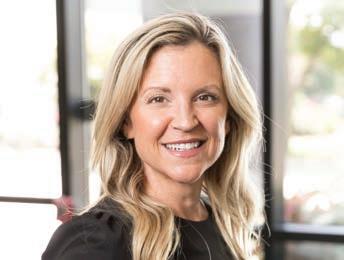
Marilyn Konvolinka,
CFP® Financial Advisor, Southfield
Many clients share that prior to working with Hantz, they did not know there were other options besides family or friends to be the trustee of their trust.
Clients work hard to build their net worth over a long period of time, so they understand the importance of teaching their children to start building their own net worth early on. The payoff can be huge Children who start learning about finances at a young age grow into adults who know how to save and manage their debt. From there, they can progress confidently through the comfort levels.
“This is an example of where instead of providing for the success of future generations, Vanderbilt’s descendants were more like lottery winners,” DeLano says. “Generation after generation, they were just spending it away.”
John D. Rockefeller, the founder of Standard Oil, had a net worth of roughly $1.4 billion in 1937 (the year he died), or about 1.5% of the U.S. GDP. To ensure the care of his family long after his death, Rockefeller set up a trust and other legal entities to manage the family fortune. The complicated web of trusts and corporations and numerous descendants makes it di cult to assess the value of the Rockefellers’ fortune today. Many of John D. Rockefeller’s descendants, however, continue to receive annual stipends
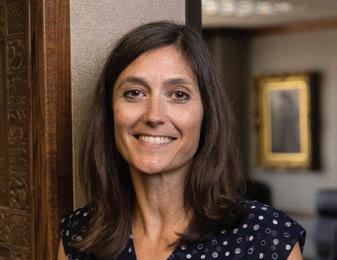
Jessica Sherman, ChFC® Financial Advisor, Southfield
In our world, there is a lot to worry about. A lot of energy is wasted on worries that will never unfold. Death, however, is inevitable. There are only so many things we can control in our lives, and death is not one of them. Creating a meaningful estate plan leaves clients with a sense of peace and preparedness. If we can reduce the stress around dying, it makes it easier to enjoy living.
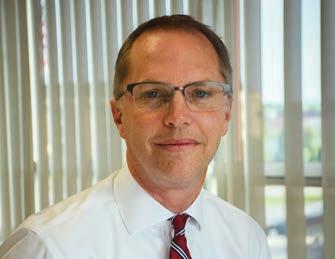
Dave
Nichols, CFP®, ChFC® Financial Advisor, Ann Arbor
If structured effectively, a client’s life’s work can produce outstanding outcomes. That is the power of sound estate planning. With the right setup, our clients can create a rock-solid foundation for financial success for their loved ones and/or their favorite charities.
The opposite, unfortunately, is also true Without a strong plan, clients may leave their heirs a chaotic, “lottery winning” mess.
Consistent communication with our clients is critical for achieving these outcomes. We help clients reflect on the skills, wisdom, and knowledge they’ve acquired over long periods of time and how those same skills can be attained by their family, even after they are gone. nowing where we came from is the first step in creating an estate plan that is a blessing, rather than a curse, to future generations.
awarded by their trusts and other financial institutions.
The examples of the Vanderbilts and of spendthrift lottery winners point to the final link in the estate planning chain beneficiary education.
“ hat we have found is that it is beneficial for children to have their own financial plan and to learn the importance of building wealth,” DeLano says.
In some ways, the Rockefellers are a good example of this David ockefeller — John D.’s grandson — ran Chase Manhattan for many years. Greatgrandson David Rockefeller Jr. serves
on the board of Rockefeller Capital Management. They learned to grow wealth, not just consume it.
DeLano says that Hantz advisors have found that estate planning “becomes so meaningful because it normally centers around family dynamics, how important children are to the clients, and how proud they are of them.”
“If you have children,” DeLano says, “they can learn what this journey is about, going through the different comfort levels as their parents did or are doing.”
Regardless of the size of the fortune they amass, anyone can create a meaningful legacy with financial literacy, planning, and Hantz’s holistic approach.


The professional organizers at Home + Sort help bring order to people’s lives
BY WENSDY VON BUSKIRK / PHOTOS COURTESY OF HOME + SORT
Two sisters out of Sacramento, California, know that being organized is a form of self-care, and for the past six years, they’ve been sharing that message with people in need of a little tidying TLC.
Ryan Eiesland and Brandie Larsen founded Home + Sort in 2018 to help people unclutter their spaces and lives. What began as an impulsive idea has grown into a successful
business specializing in professional organizing and luxury moves, with a line of products, an annual conference for organizers, a newly published planner, and clients across the country, including the Hantz Foundation.
Along the way, the siblings have found that when people unclutter their spaces, they often clear their minds as well.
“A lot of people are kind of suffocating in their stuff, and so I think when we can help simplify people’s spaces, it can overarchingly simplify their life,” Eiesland says.
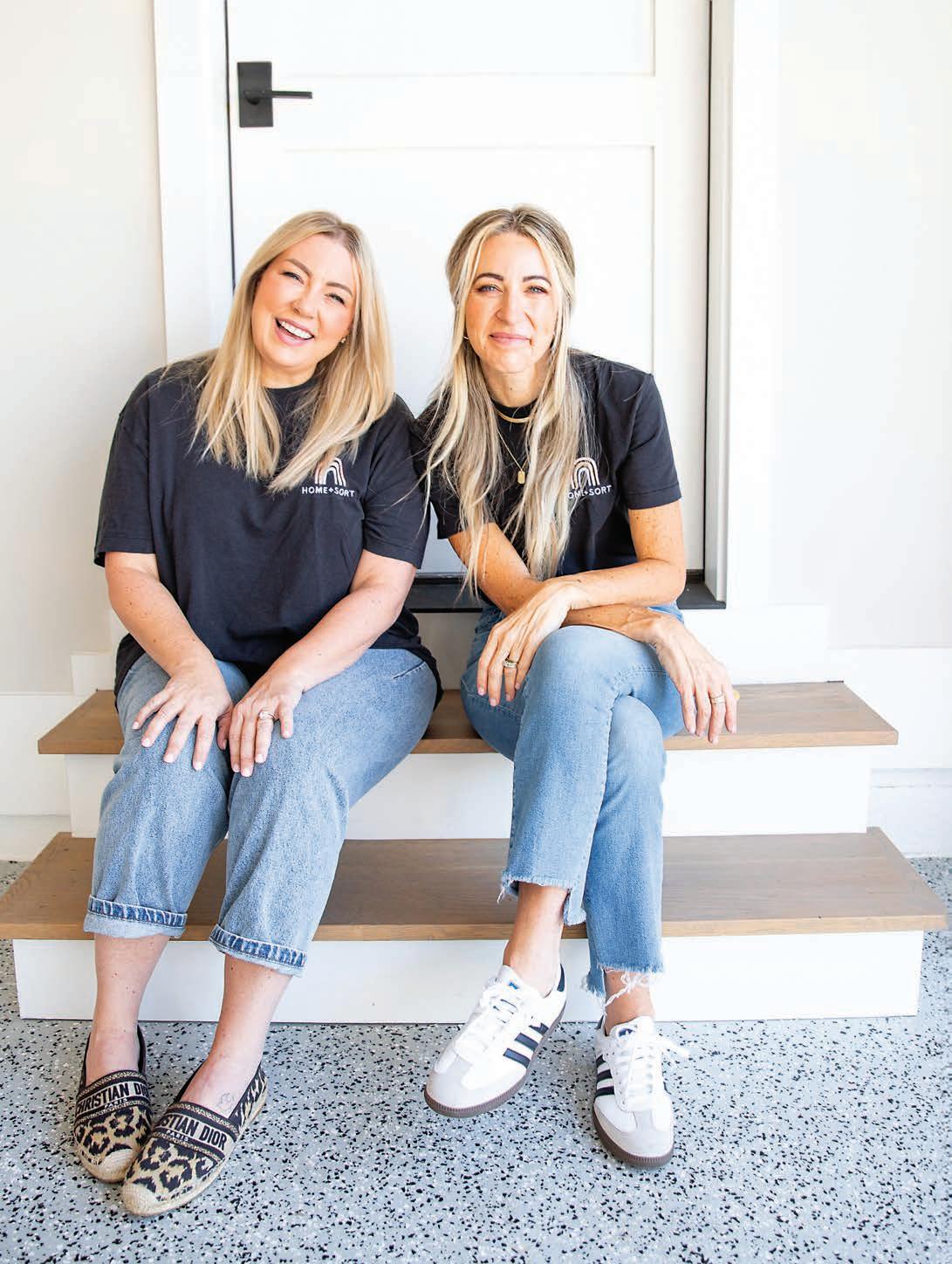

“EVERYONE’S STUFF TELLS A STORY.”
—RYAN EIESLAND, CO-FOUNDER OF HOME + SORT
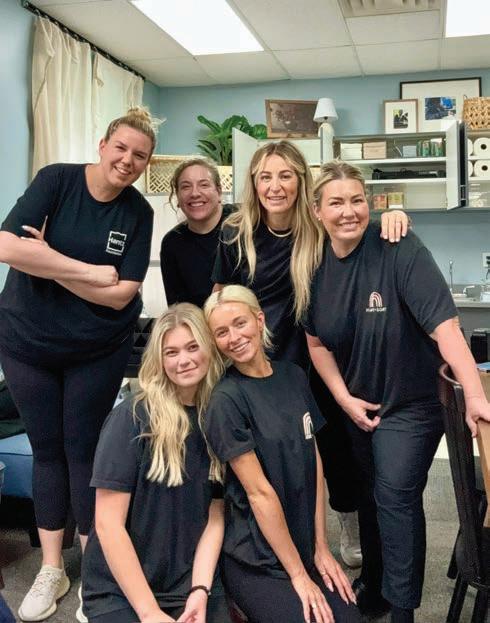
Eiesland and Larsen first floated the idea for Home Sort (pronounced “home sort”) during a casual conversation by the swimming pool.
“ e just decided that we wanted to start this business,” Larsen explains. “ e gave ourselves like a month and hit the ground running. Somehow, out of nothing, we have made it work and have had great success.”


The sisters credit their mom, who owns a criminal background research company, as their inspiration.
“She was an entrepreneur before it was a thing for women to be entrepreneurs, so that’s just all we knew,” Larsen says.
ith their sibling banter and relatable approach, the sisters have made their profi le grow along with their client base. They’ve been featured on HGT and The Design etwork, as well as in People, Forbes, and Architectural Digest. They’re sought after by sports stars and celebrities.



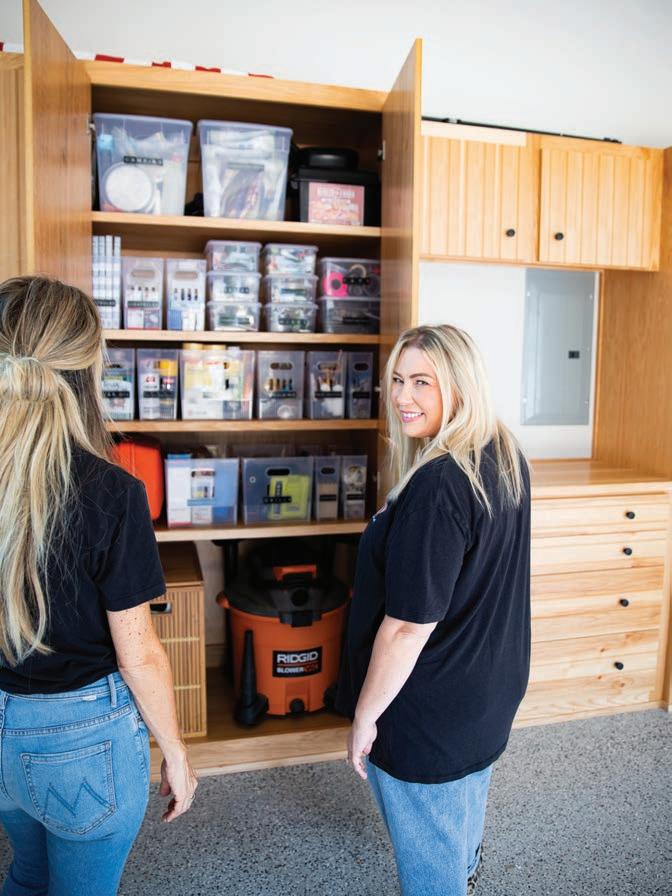
The Home + Sort team organizes all kinds of spaces, including closets big and small.
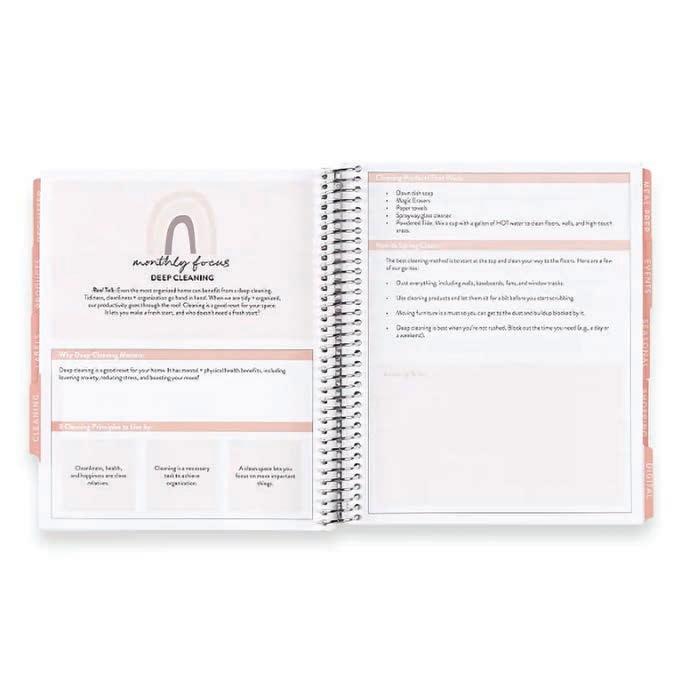
“WHEN WE CAN HELP SIMPLIFY PEOPLE’S SPACES, IT CAN OVERARCHINGLY SIMPLIFY THEIR LIFE.”
—RYAN EIESLAND, CO-FOUNDER OF HOME + SORT
Lauren Hantz, president of the Hantz Foundation, was so impressed with their work that she brought the company in to help with the Hantz Foundation’s efforts at two schools during Teacher Appreciation Week (see related story on page 10).
Eiesland and Larsen have brought their team to Detroit two years in a row now. In 2023, they organized classrooms at Hutchinson Elementary-Middle School at Howe and Detroit Enterprise Academy. Staff at each school voted, and winners got complete classroom makeovers.
“Teachers’ lives are pretty chaotic,” Larsen says. “You’re trying to teach and think about millions of other things teachers have to do throughout the day.”
In classrooms with high-risk populations, teachers are called upon to provide more than
just an education. The sisters found themselves organizing clothing, food, hygiene products, medical supplies, and more.
“Being able to support the teachers and make such a difference in these kids’ lives is a really cool thing to be a part of,” Eiesland says.
In 2024, Home + Sort returned to organize teachers’ lounges in both schools. Volunteers from Hantz Group joined the effort, spending back-to-back weekends to help deep clean, paint, furnish, and transform the spaces.
Hantz says the project was di cult but rewarding.
“You saw the teachers and administrators walk into these rooms and literally start crying,” she recalls. “They didn’t think they would ever have that level of relaxation or stress relief just from reorganizing their stuff.”
Home + Sort’s spiral-bound organizational planner includes project ideas and expert tips.
1. Edit your space. Make a list of things to toss/donate:
•Broken things
•Items that have seen a better day
•Items you no longer need
•Clothing that no longer fits
•Toys that no one plays with
•Sets that are missing pieces/ incomplete
Even if these items were expensive, don’t hold onto things that don’t serve you.
2. Make sense of what you have. Create zones and categories, and place like items together.
Ask yourself:
•How do I use my space?
•Are my items easily accessible?
•Is my space working for me?
3. Figure our products that work for you.
•Hangers
•Bins
•Baskets
•Turntables
4. Reset your space. What came out must go back in!
Source: Home + Sort, homesort.org


The sisters’ business has grown to include products and an annual conference.
Home + Sort strives to make spaces functional and beautiful. The process begins with meeting the client to understand their vision. Then, the sisters start with a blank slate.
“We always remove everything from the space, then sort it, categorize it, and figure it out so we have eyes on what kind of real estate we have and how much stuff actually needs to go back in,” Larsen says.
Through the process of excavating clutter crammed into corners, closets, and drawers, Home + Sort crews have found long-lost treasures such as family photos, wedding rings, and even an Olympic medal. More often, they find items that are no longer useful and help clients come to grips with letting go.
“Sometimes the pathway to get where someone wants to be involves some editing and some changes,” Eiesland says.
Working with clients to sort through their things creates an intimacy the sisters weren’t expecting when they started Home + Sort.
“Everyone’s stuff tells a story,” Eiesland says.
There’s an element of psychology, as clients confront why they might be hanging onto items that no longer serve them.
The condition of someone’s home can affect their state of mind, Eiesland says: “If every day you pull into a garage that’s a disaster, that gives you anxiety. That’s what you leave from every single morning, and it’s what you come home to. That really affects how you live.”
A chaotic closet can make it hard to look pulled together, and a messy home can make people ashamed to have people over. Home + Sort restores a sense of order and control.
“Sometimes we just go in and beautify a closet and there are no issues, but then there are other times when people feel really stuck in their stuff and we’re able to help them live their life differently and live the life that they want to live,” Eiesland says. “We give people some freedom in some areas that they haven’t had before.”

To share what they’ve learned, the sisters have developed an organizational planner in partnership with the stationery maker Erin Condren. The 124-page spiral-bound notebook ($32.50) guides people on their own “organizational living adventure,” with month-by-month projects and expert tips.
The pair also partnered with the company mDesign to create a series of stylish organizational products. They’re all available in Home + Sort’s Amazon store.
The sisters host an annual conference for professional organizers as well. The three-day “How To: Summit” focuses on empowering female entrepreneurs through coaching and connections. The 2024 event, held at Erin Condren headquarters in Austin, Texas, sold out.
The company that arose six years ago from poolside banter has turned into a full-fledged lifestyle brand. “ e originally thought we just wanted to beautify spaces,” Larsen says, “but the more we got into it, the more we realized your stuff can weigh you down. We’re helping people make space for the lives they want to lead.”
Founder and CEO John Hantz reflects on why leading clients to a debt-free lifestyle — and often saving them a huge amount of time and money in the long run — is so important
Alittle refinancing in today’s housing market can go a long, long way. Hantz Group clients are living proof of that.
Using refinancing strategies, Hantz Group is on track to cut almost 2,500 years, collectively, from clients’ mortgages in the span of six months. That works out to roughly $53 million in interest payment savings.
Debt-free living is a pillar of Hantz Group’s financial planning philosophy, and working with clients to shave both time and money off their mortgages is one of the major ways the company helps those clients get there.
The concept might seem a little strange in a culture where having debt is the norm. After all, the U.S. national debt is at $35.5 trillion and counting (as of mid-2024), and the average American has $104,215 in debt. It’s no wonder that many Americans believe that living with debt is just a way of life.
John Hantz, founder and CEO of Hantz Group, believes otherwise. “Most folks don’t understand being debt-free until they’ve reached debt-free,” he says. “It’s liberating.”
Clients who achieve this debt-free milestone have greater flexibility, the capability to handle risk, and ultimately more peace of mind. Getting there, however, requires changing habits, setting clear financial goals, and establishing the right strategies and tactics. “Like most things in life that are worthwhile, you need to work at it,” Hantz says. “Becoming debt-free is not inevitable.”

“MOST FOLKS DON’T UNDERSTAND BEING DEBTFREE UNTIL THEY’VE REACHED DEBT-FREE. IT’S LIBERATING.”
—JOHN HANTZ, FOUNDER AND CEO OF HANTZ GROUP
A common area for working toward the debt-free goal is a client’s mortgage, which can feel like a substantial, never-ending burden given the amount and term lengths typically attached. As those 2,500 years and $53 million show, the payoff of aggressively tackling a mortgage can be huge. But to do that, you have to have the right strategy and habits in place. An additional $100 a month toward a mortgage, applied in combination with other effective tactics, can shave years off a mortgage repayment timeline and reduce the amount of overall interest clients owe. (See “The Power of $100” on page 36.) That’s a small price to pay to reach debt-free status years earlier and save thousands along the way.
From there, clients can enjoy the freedom that comes from debtfree living and focus on using their money how they like and leaving a legacy for future generations.














Many parts, one comprehensive strategy